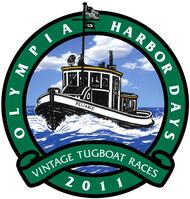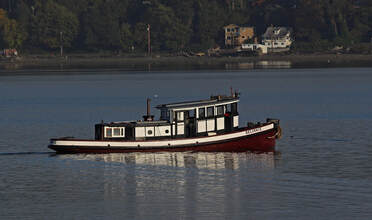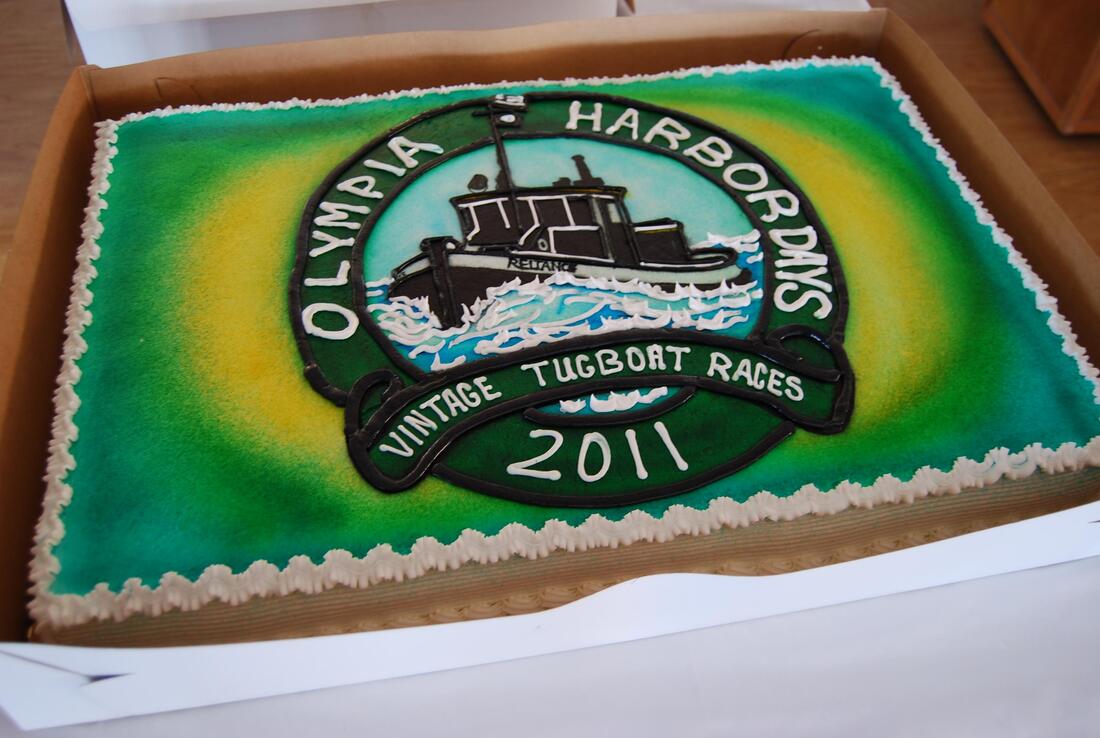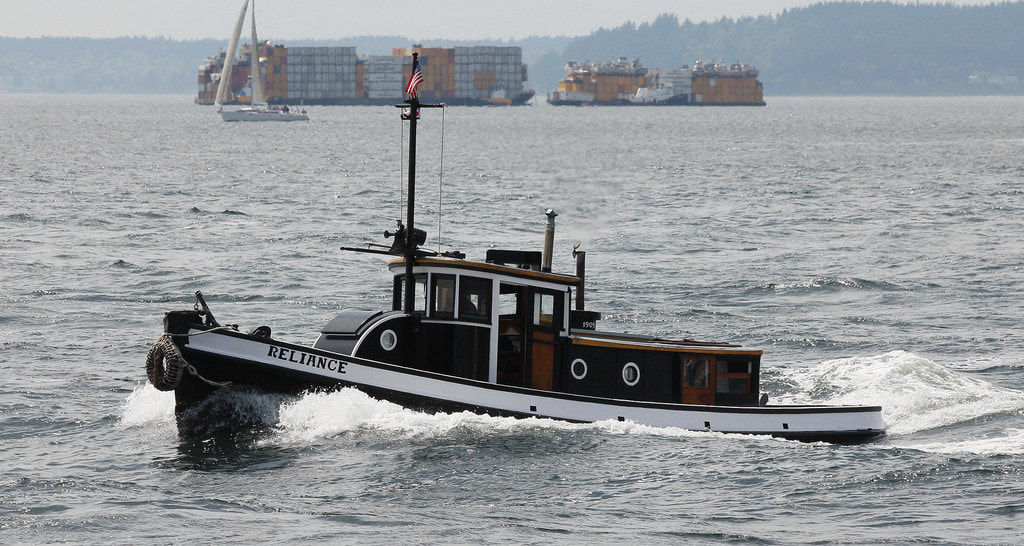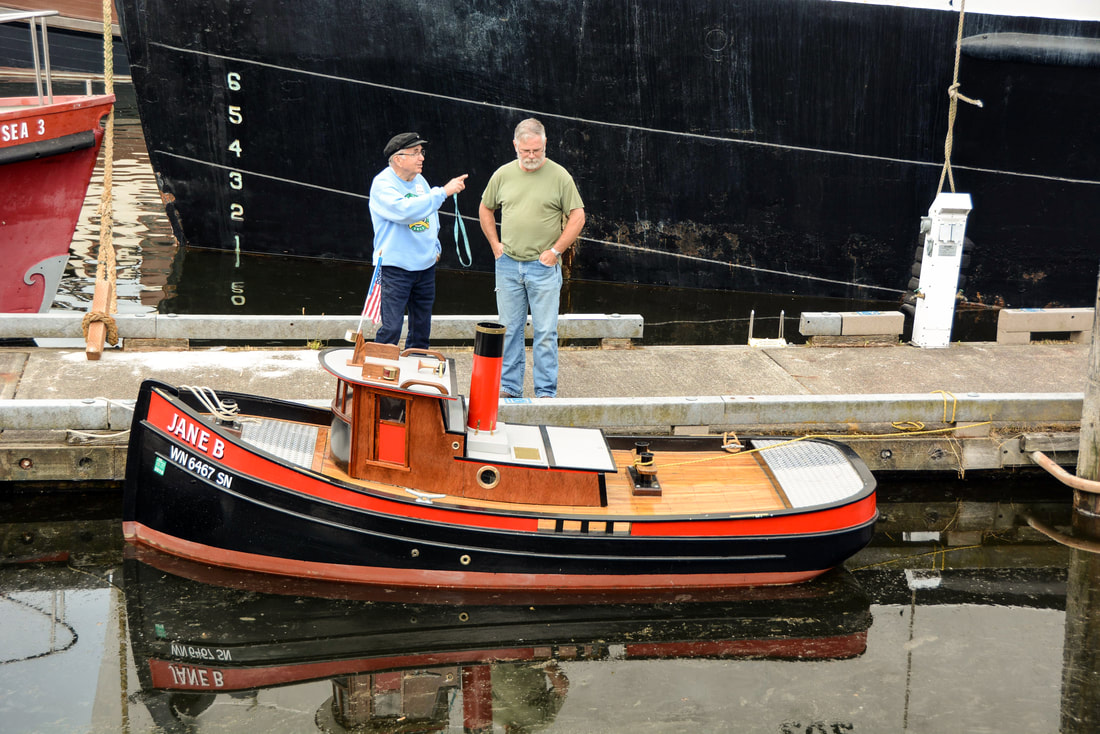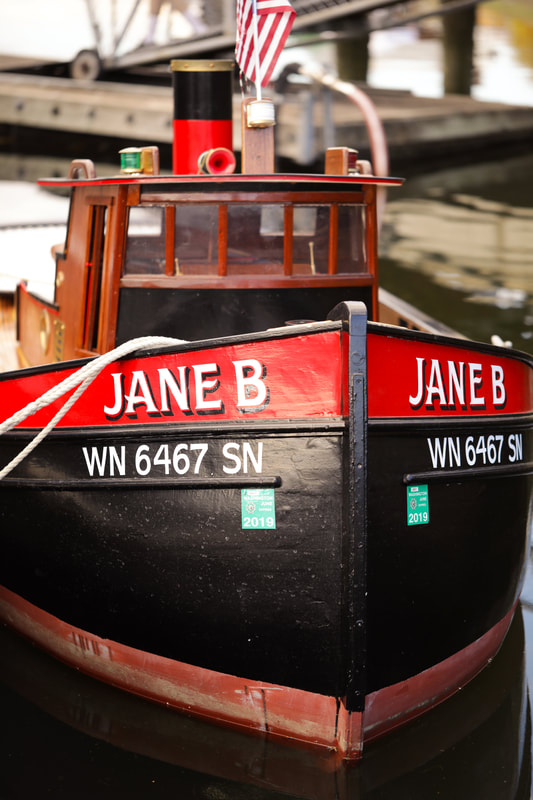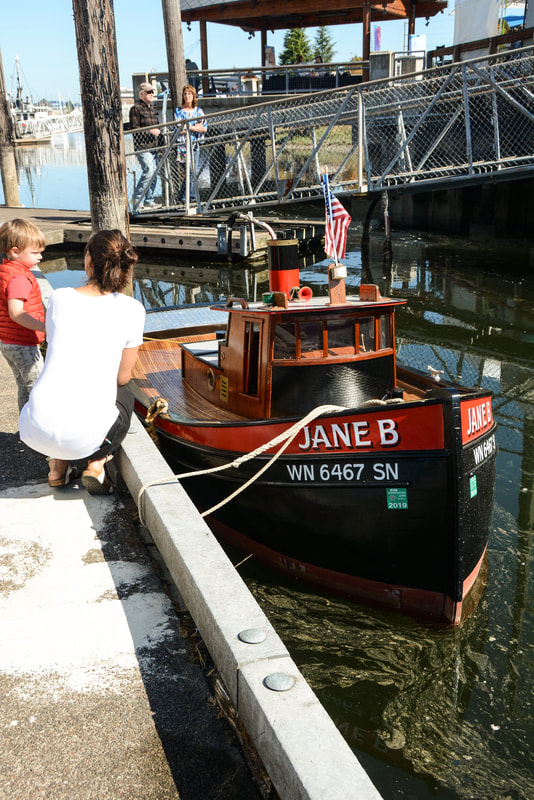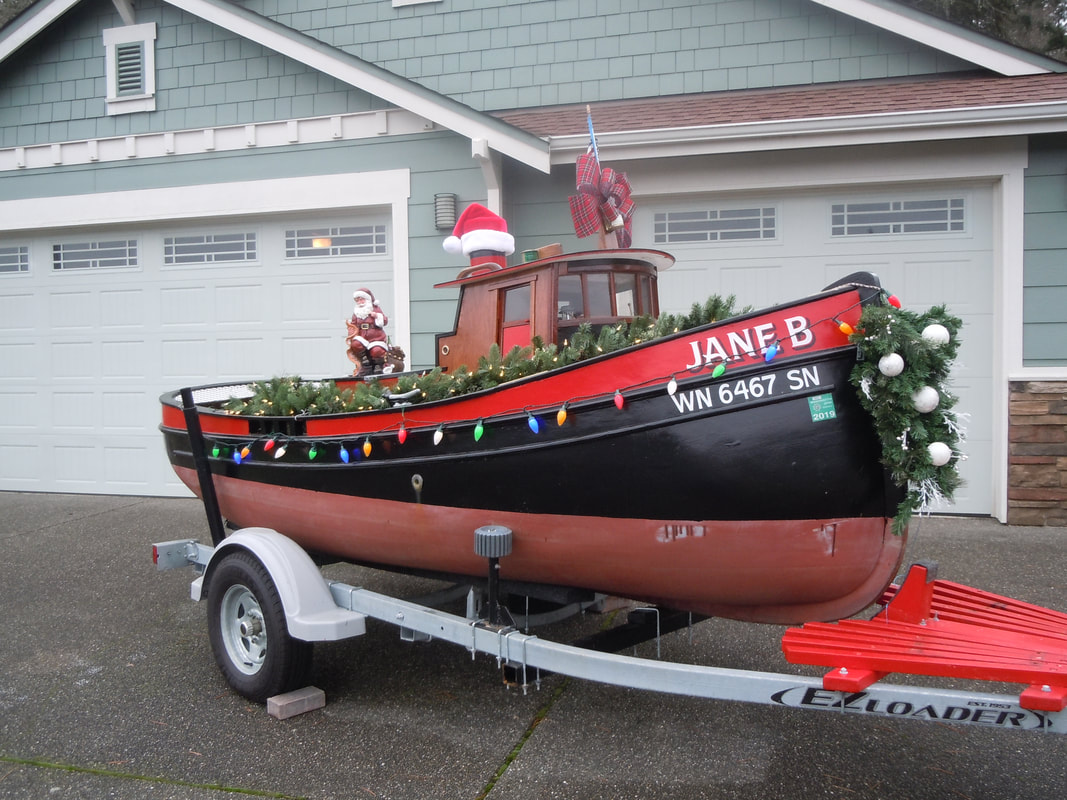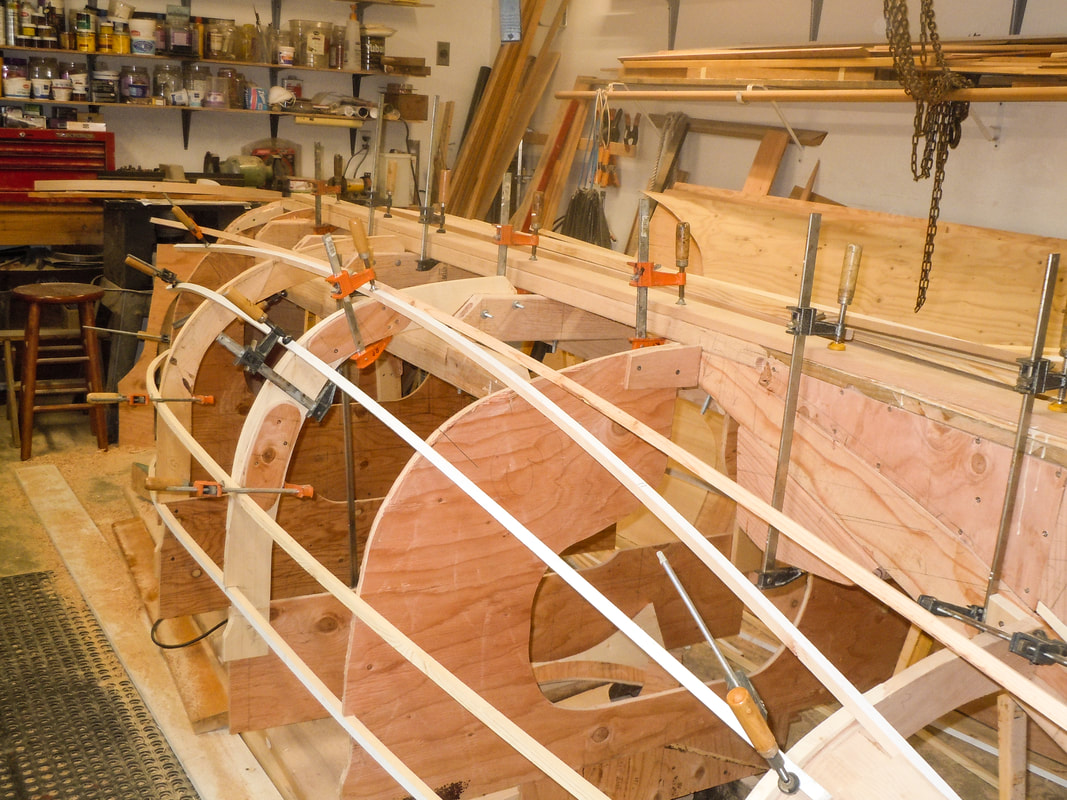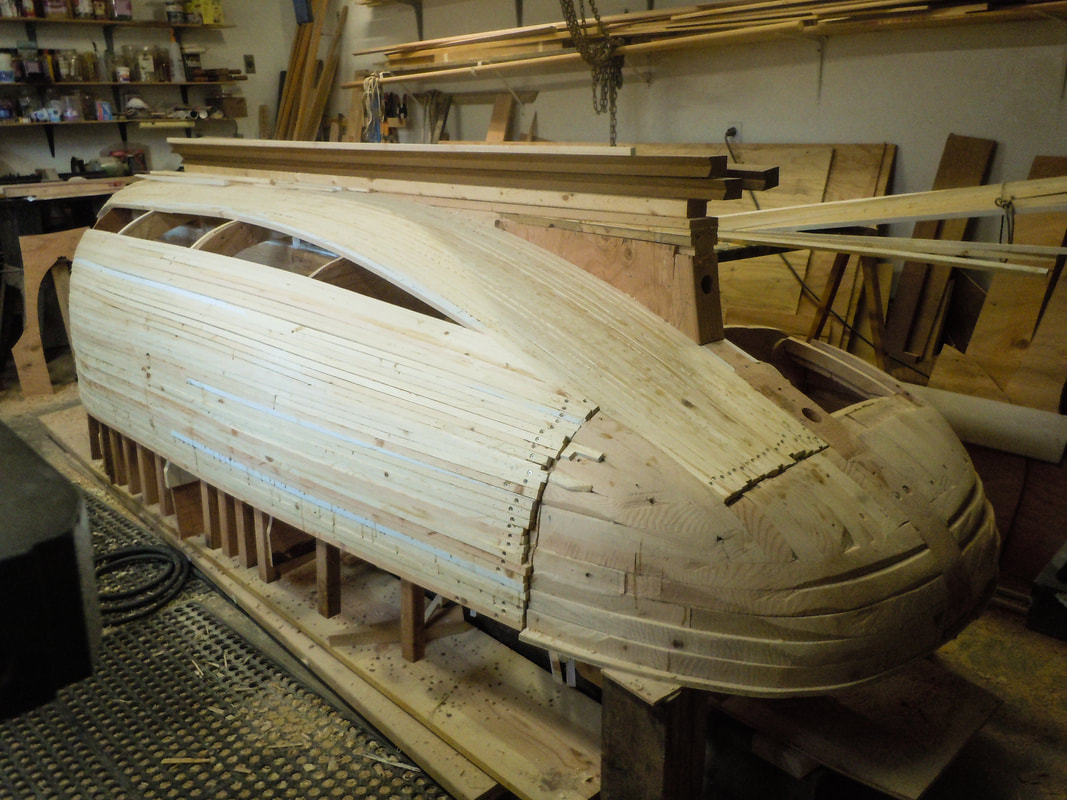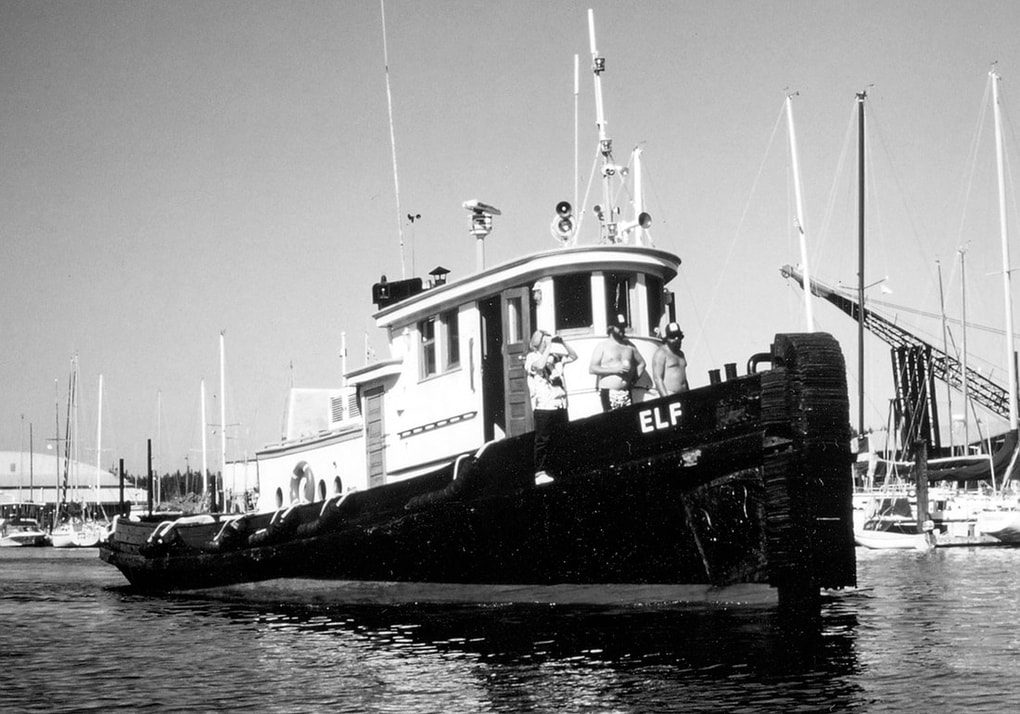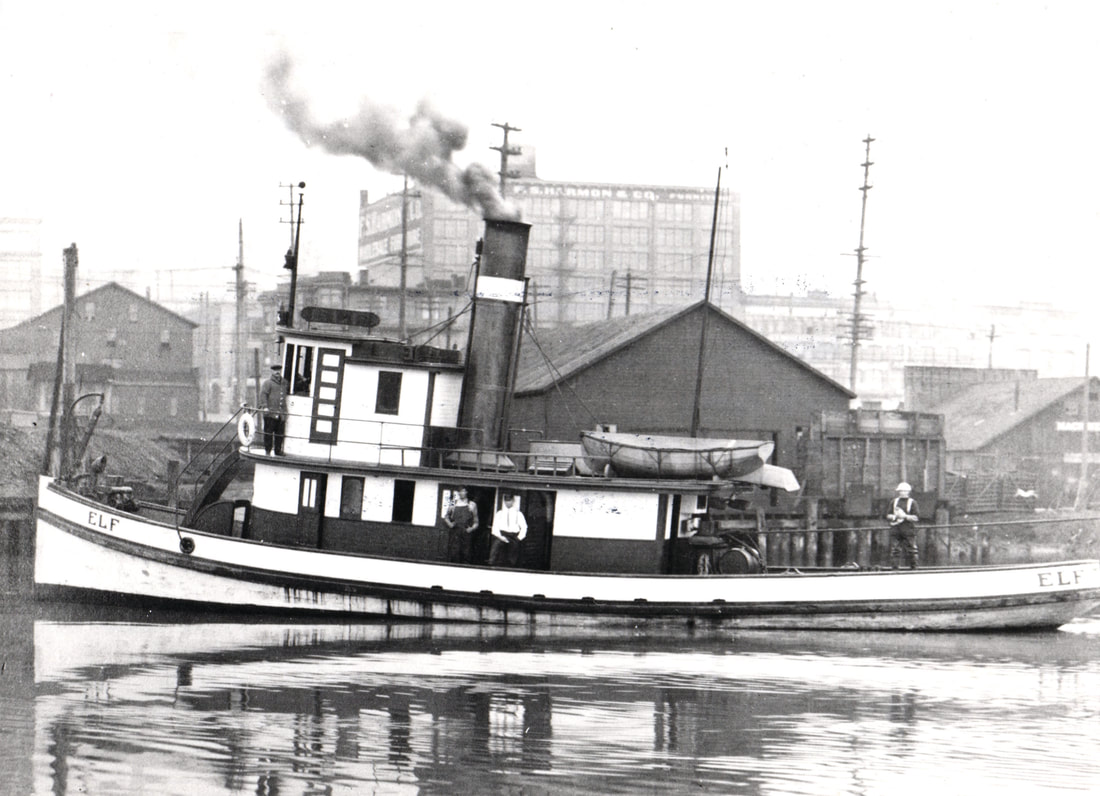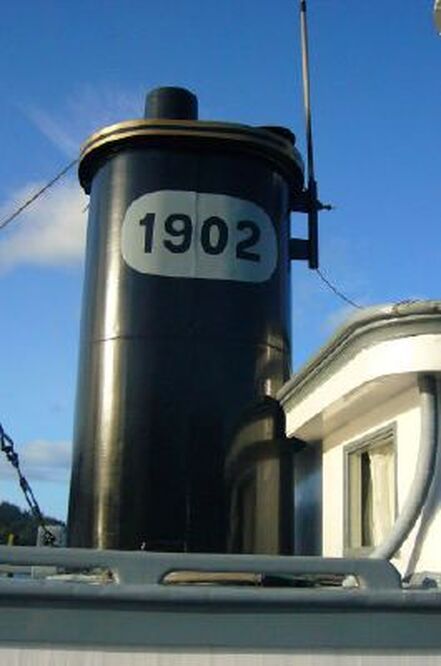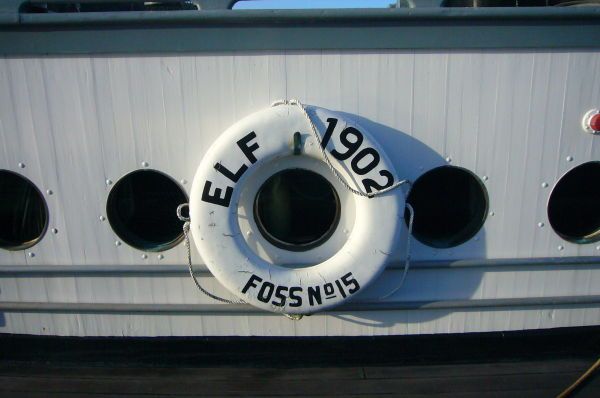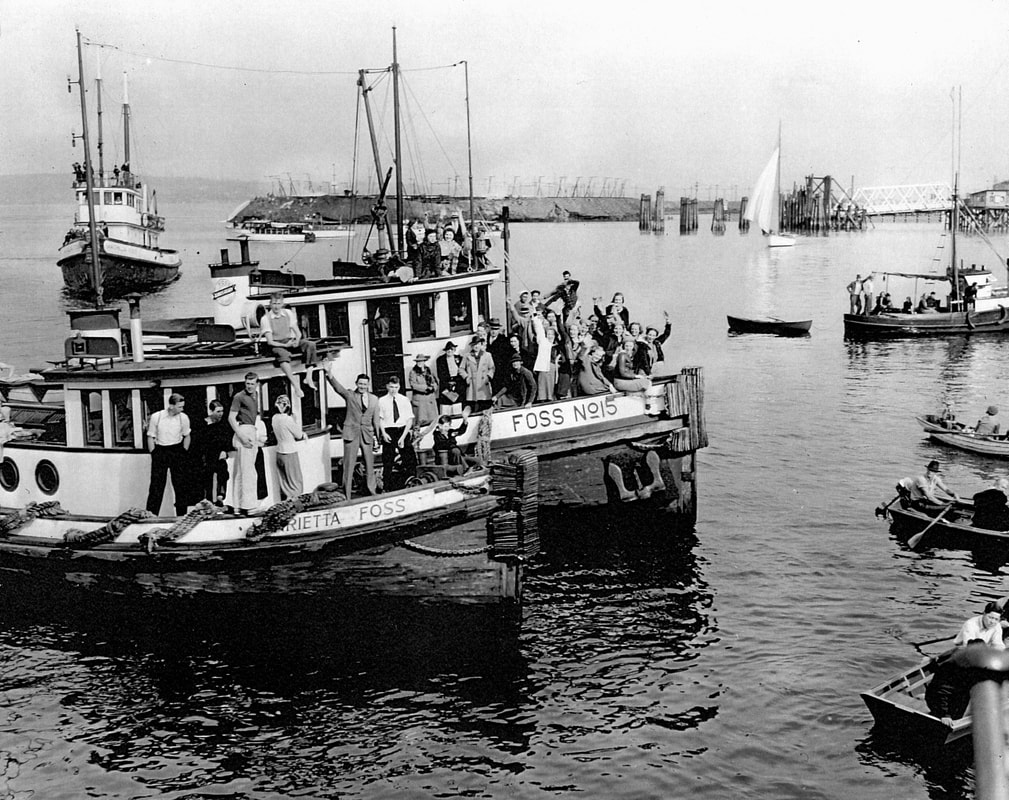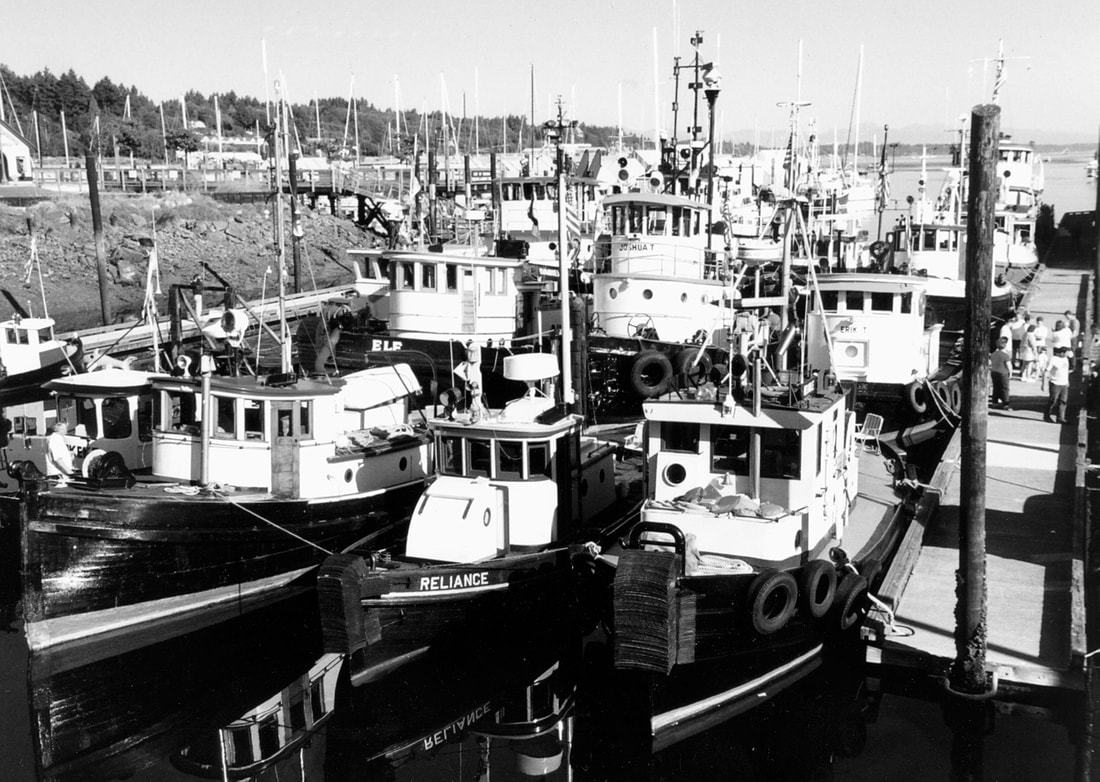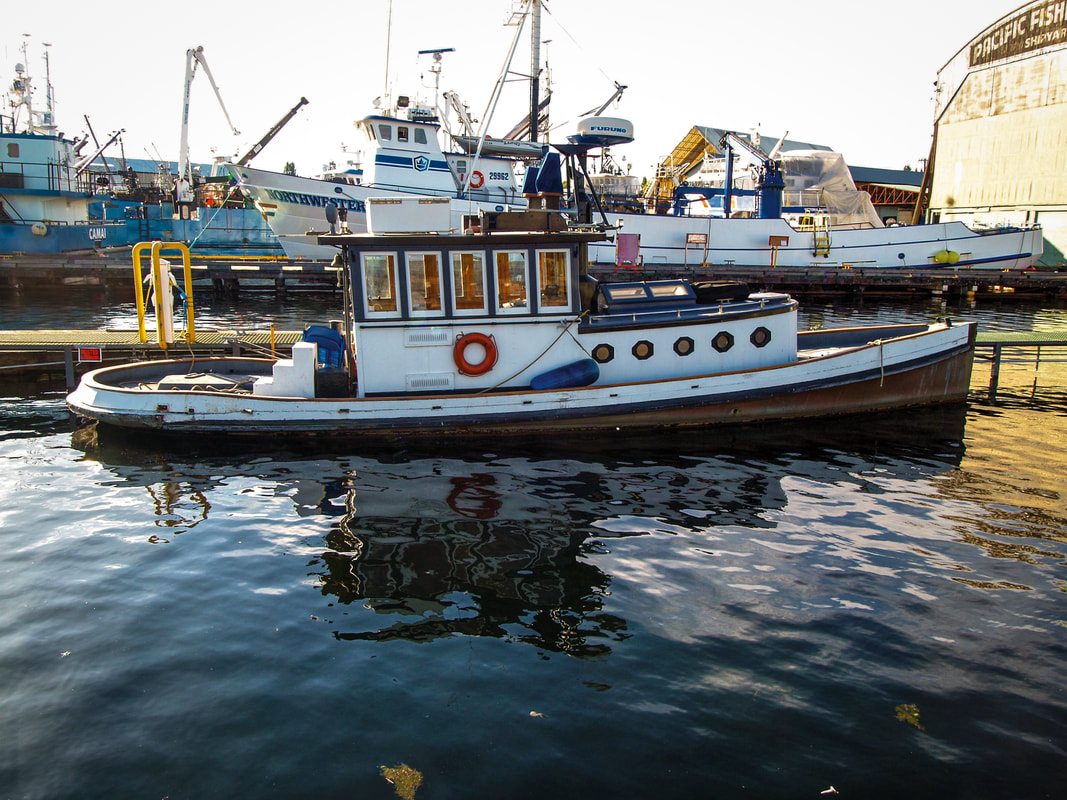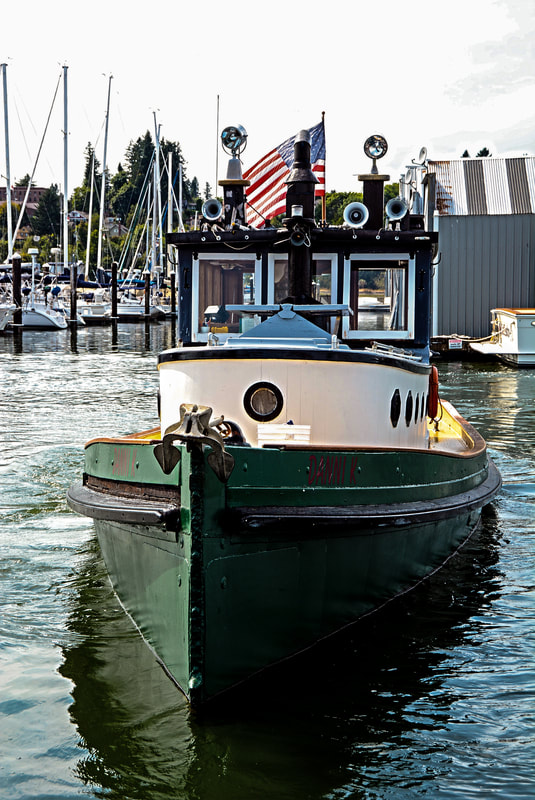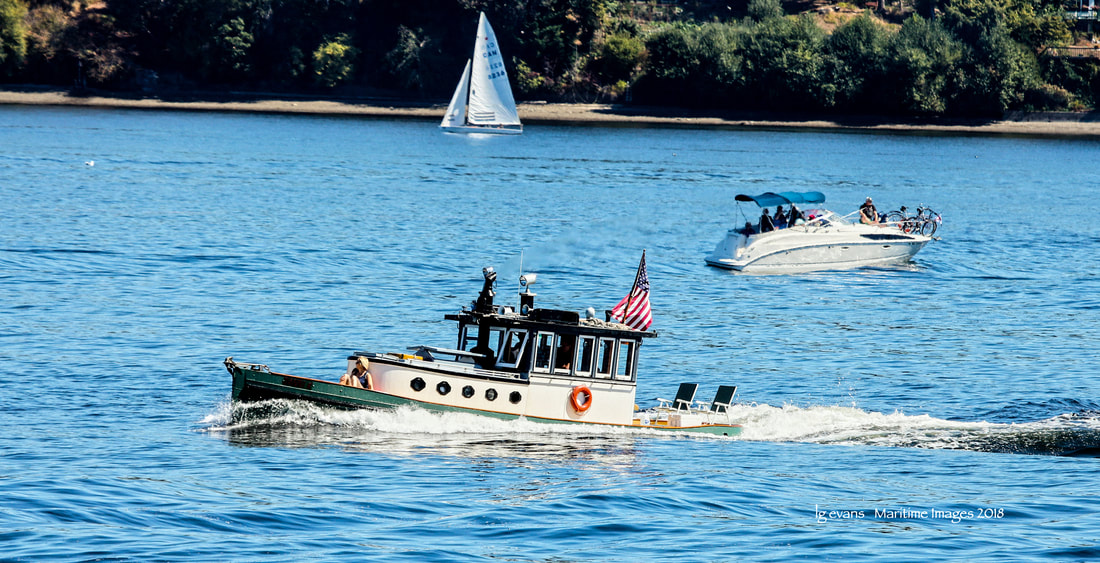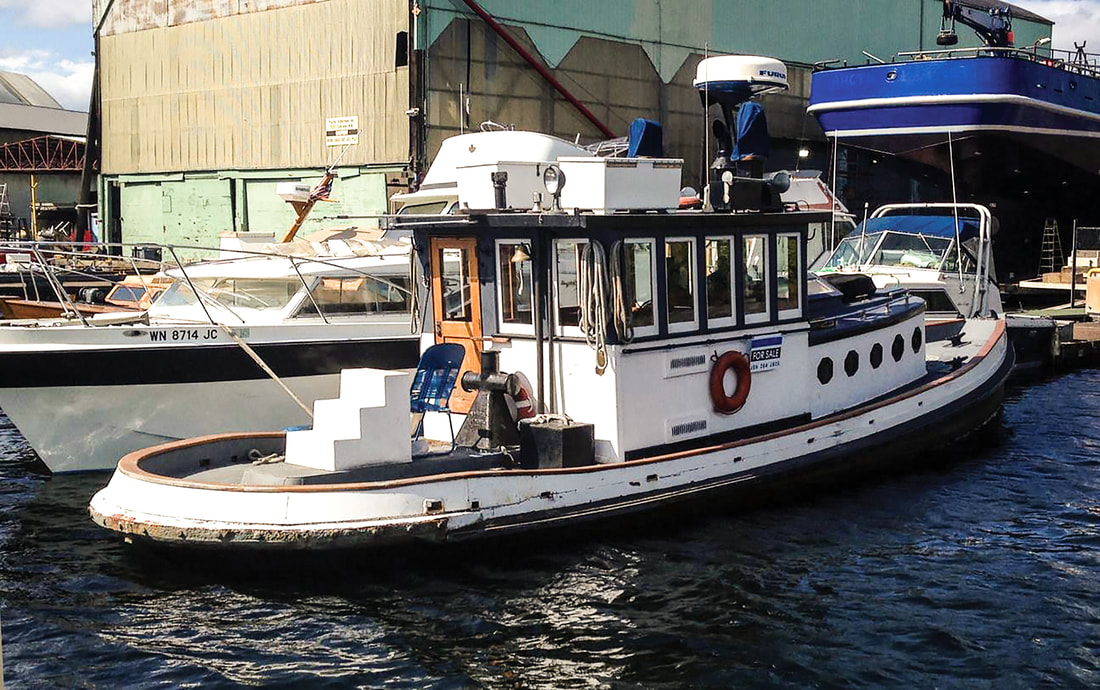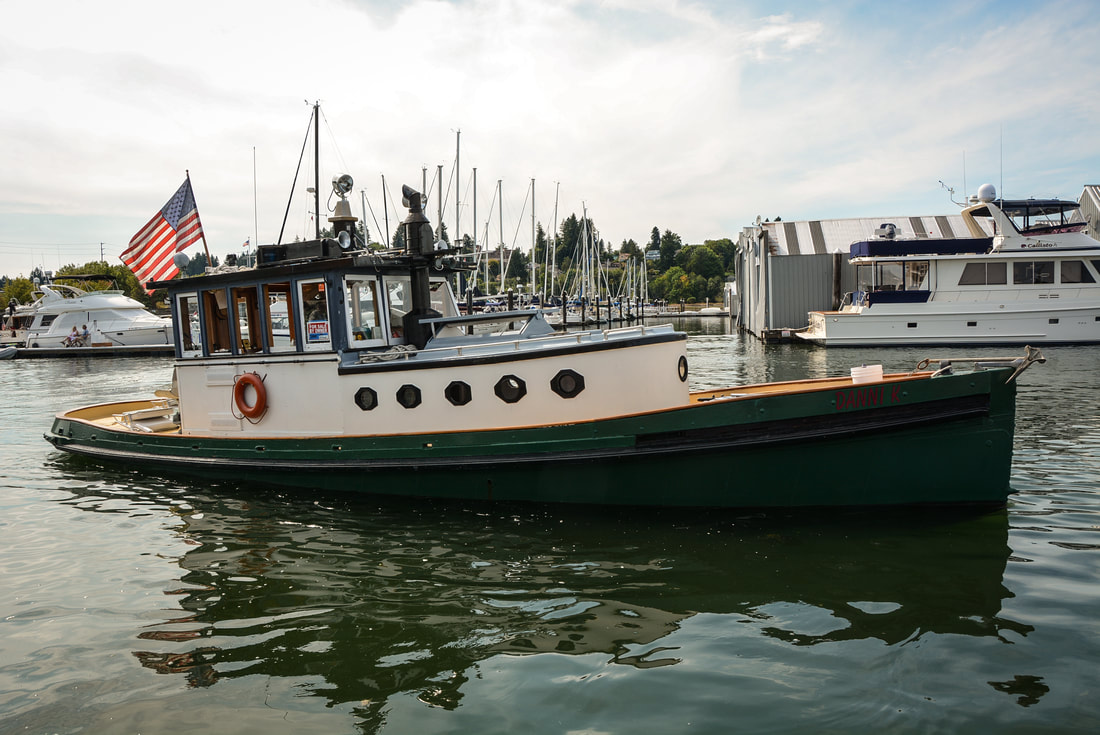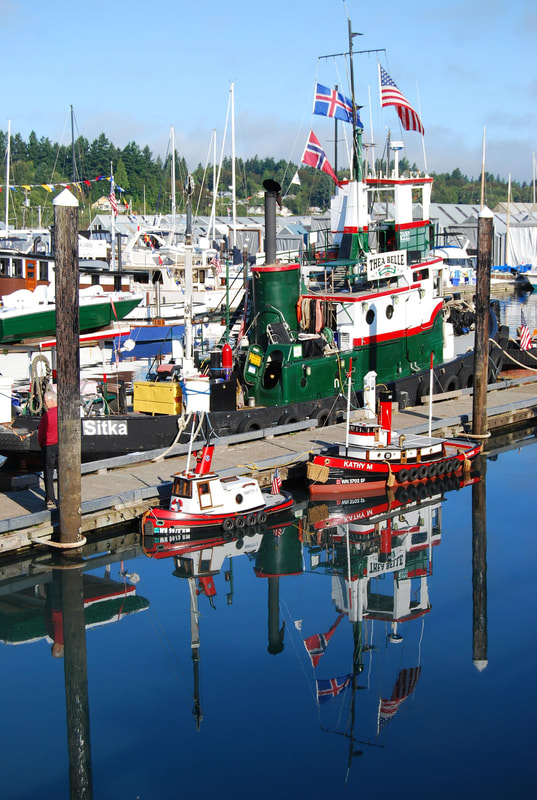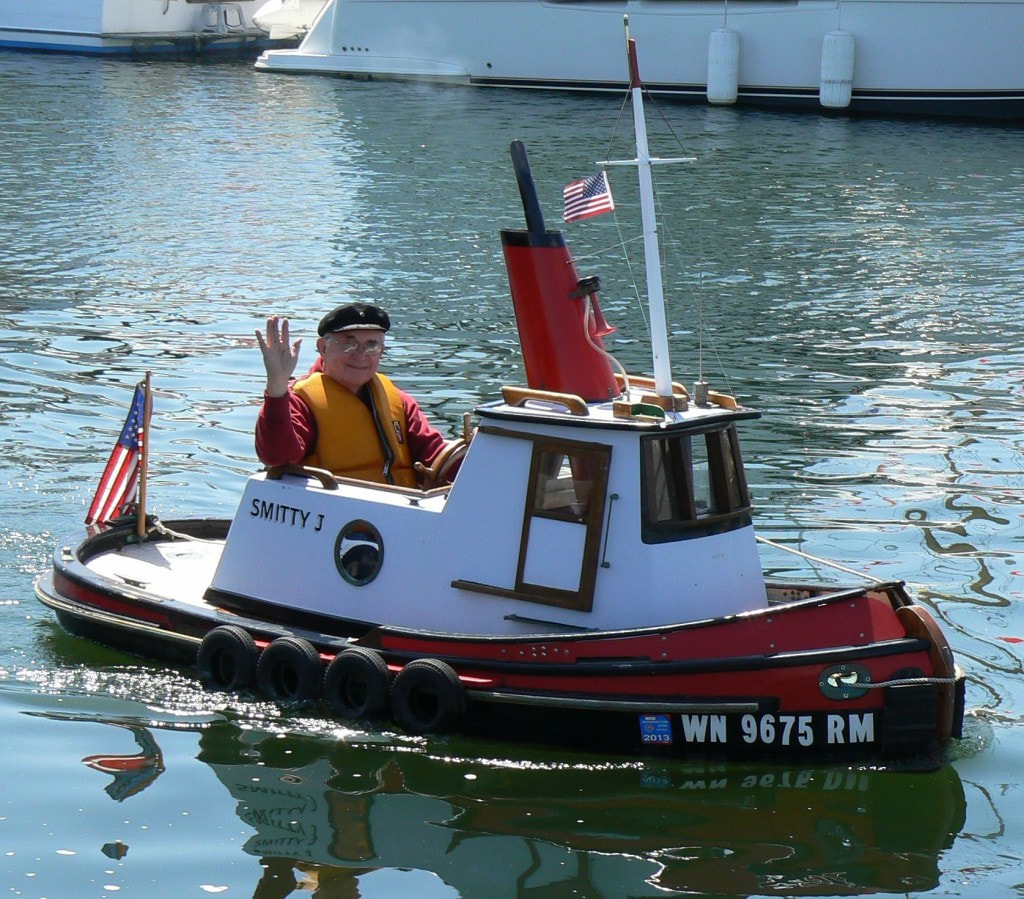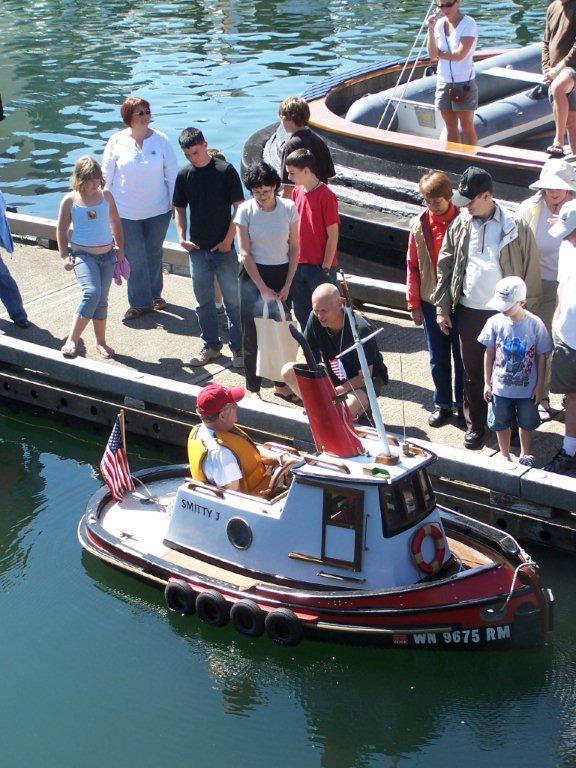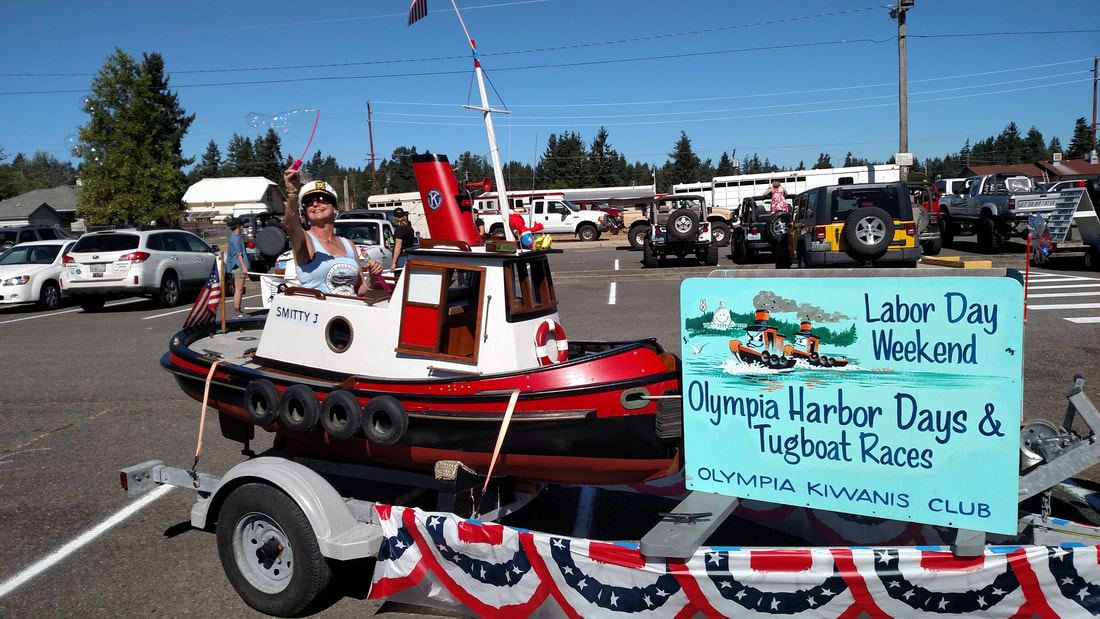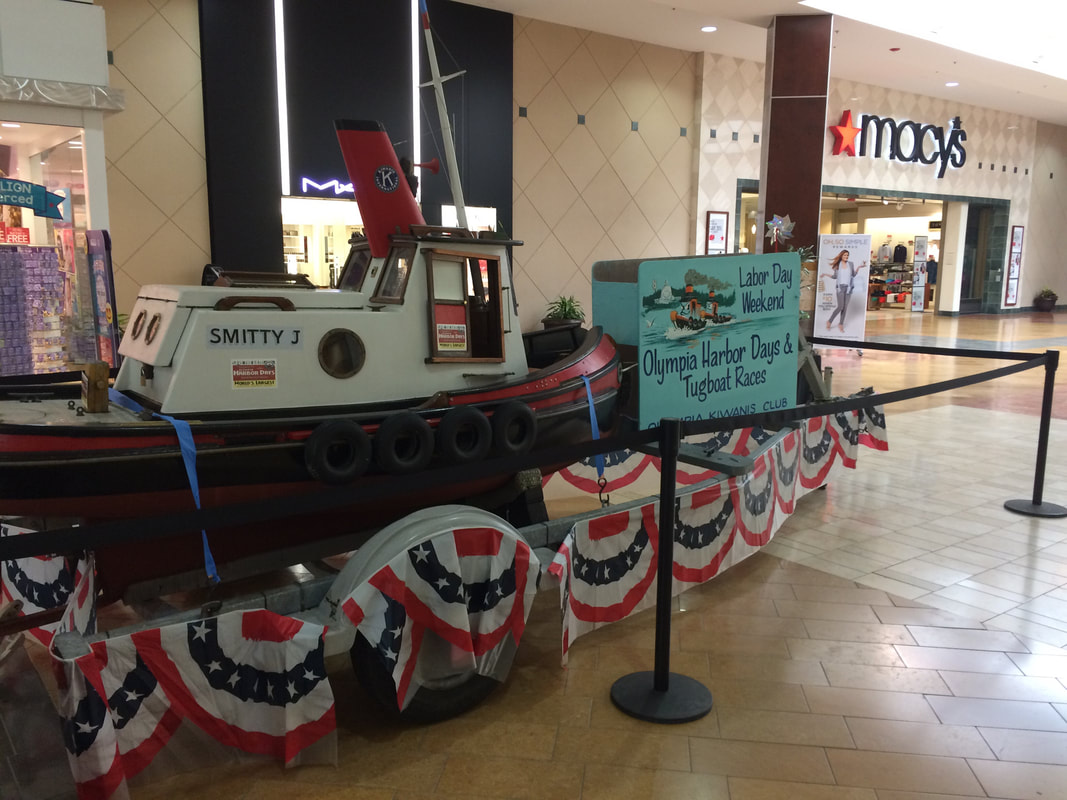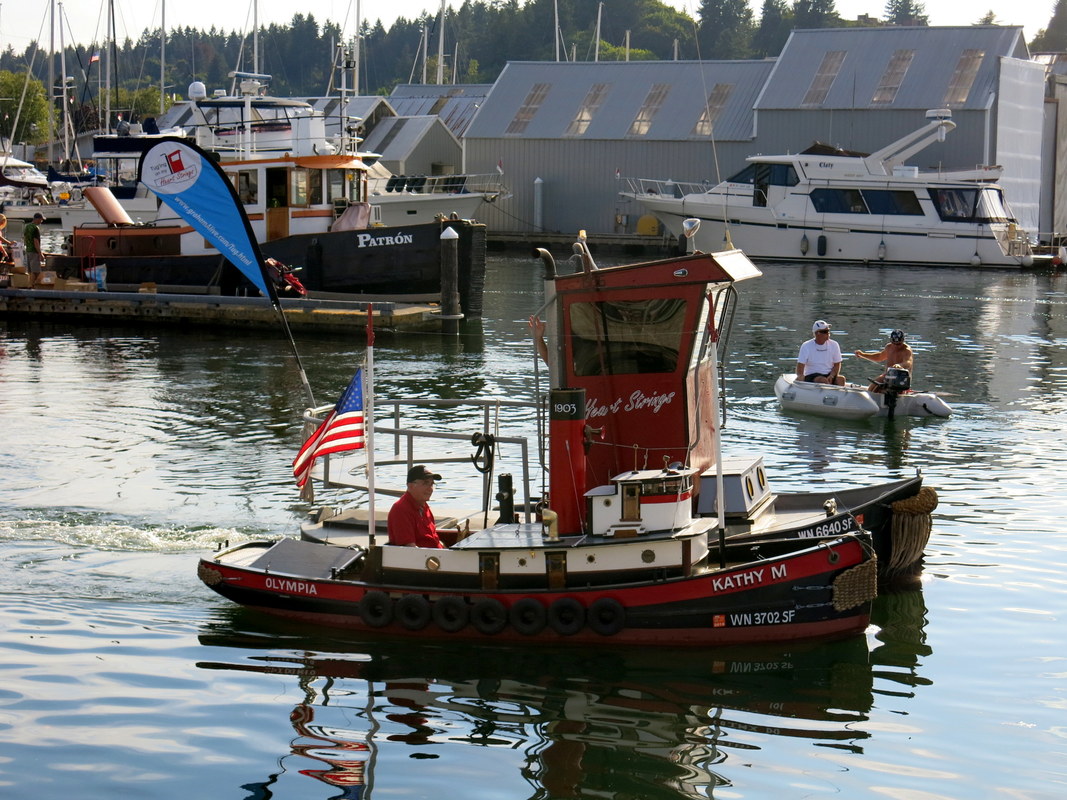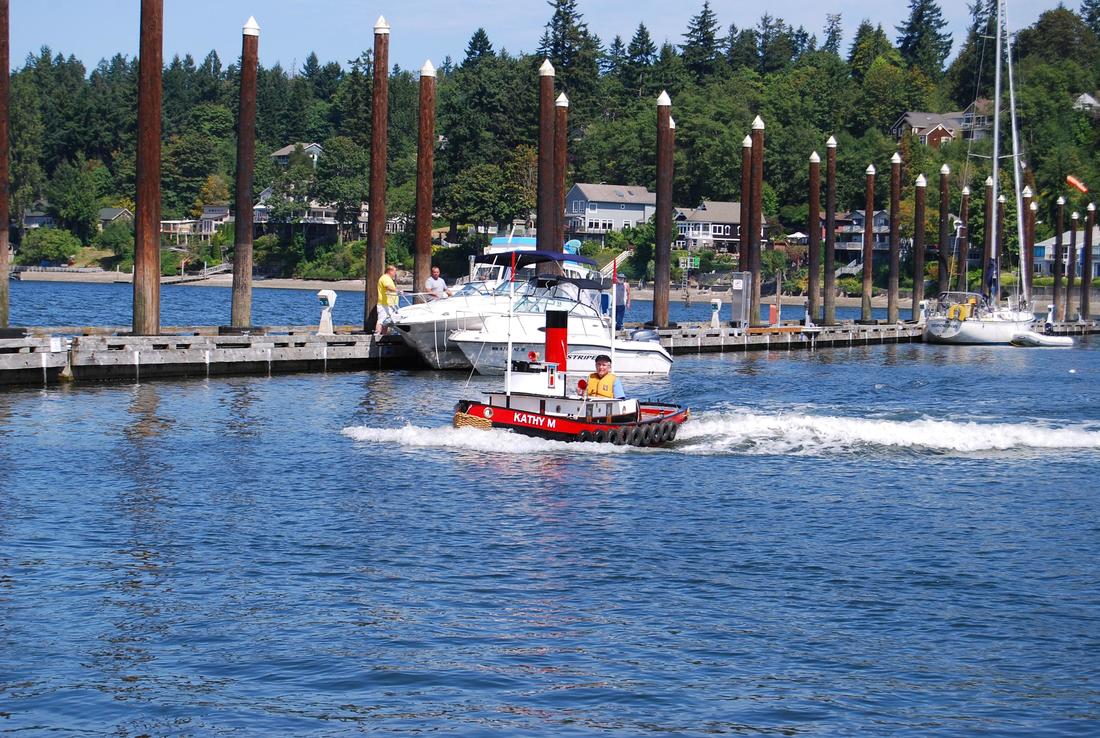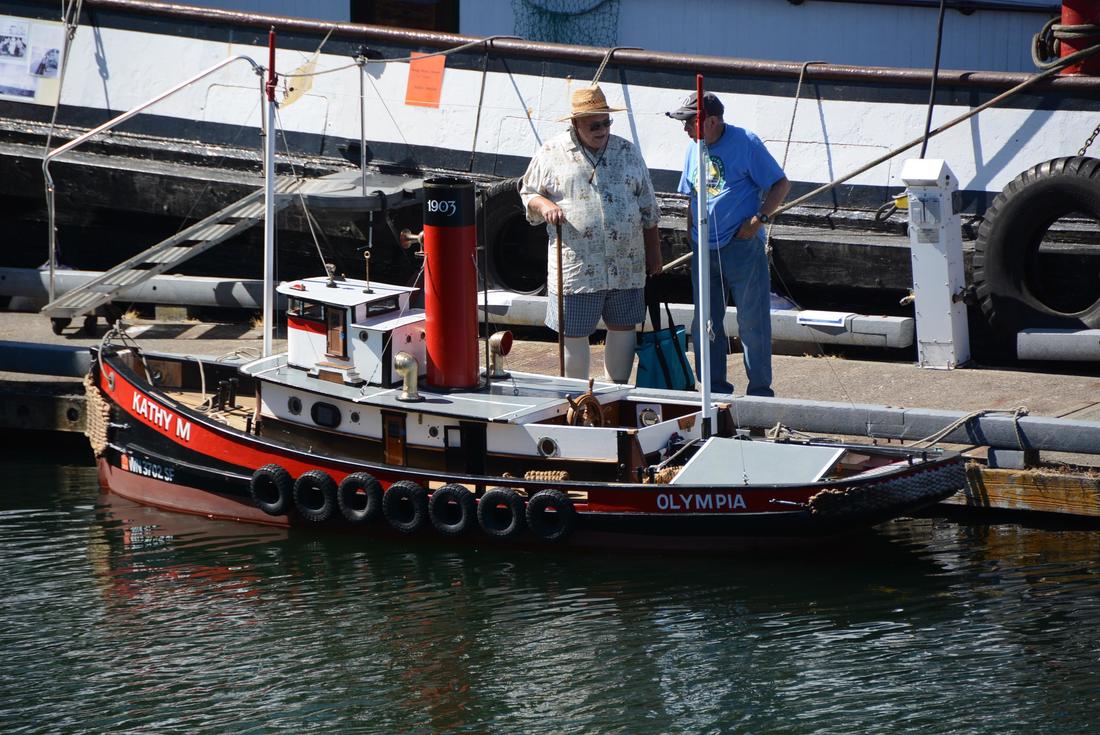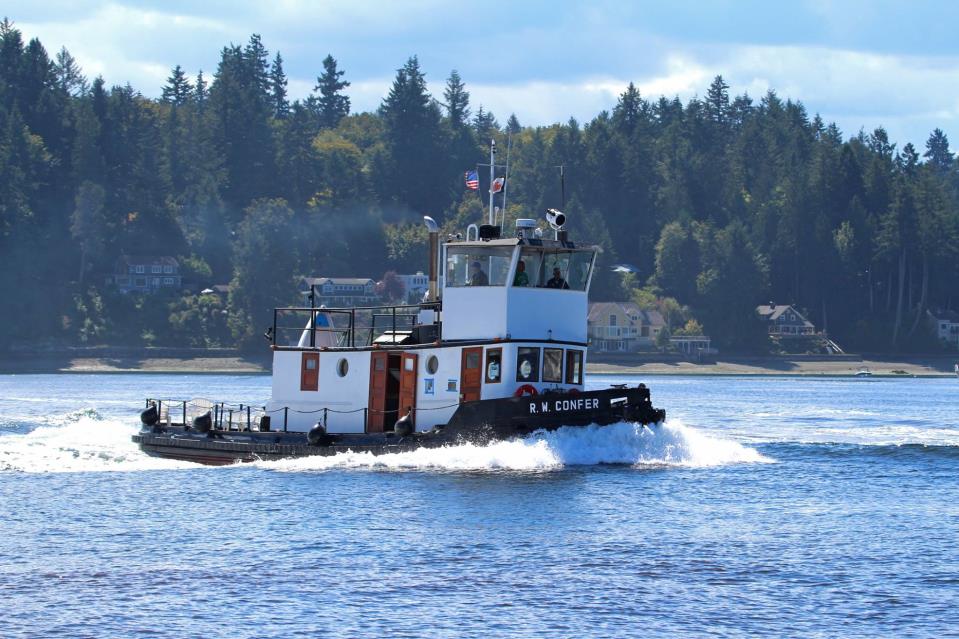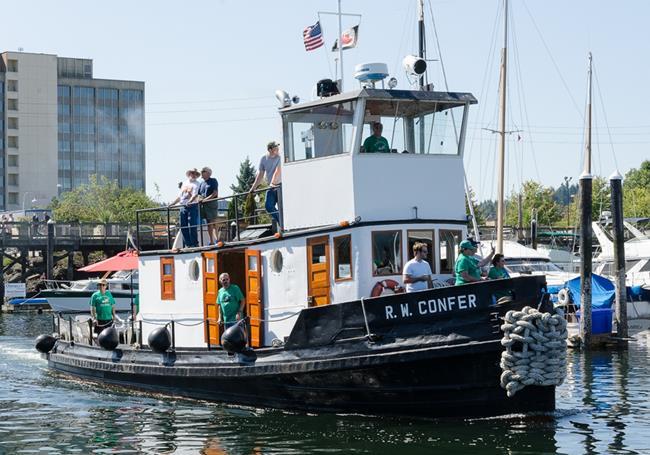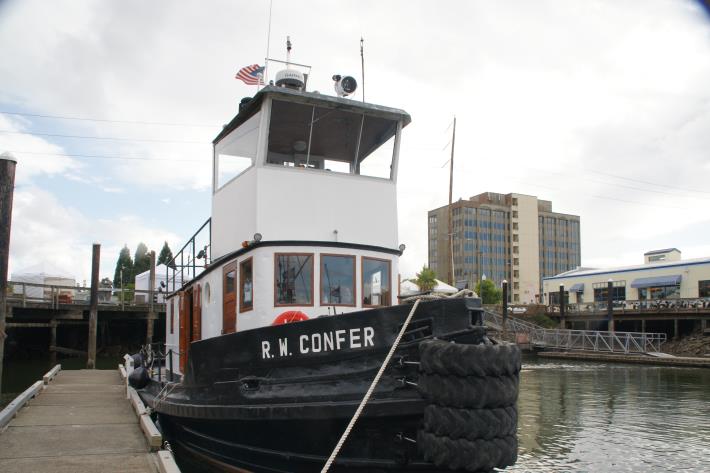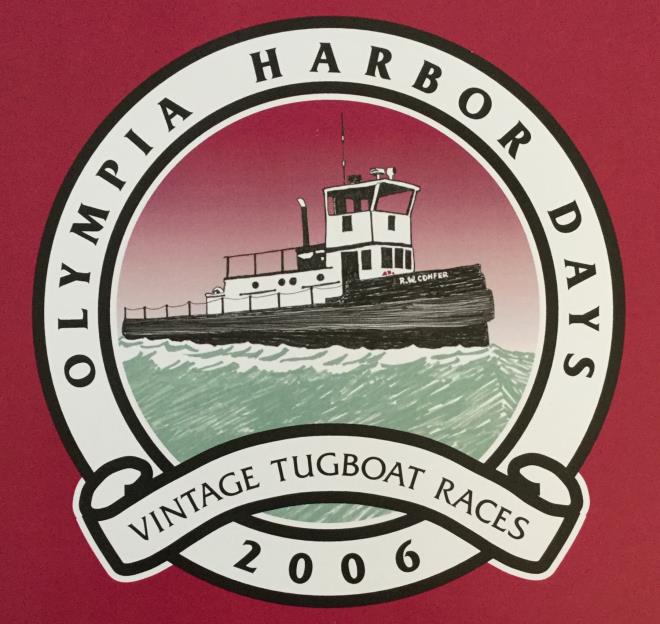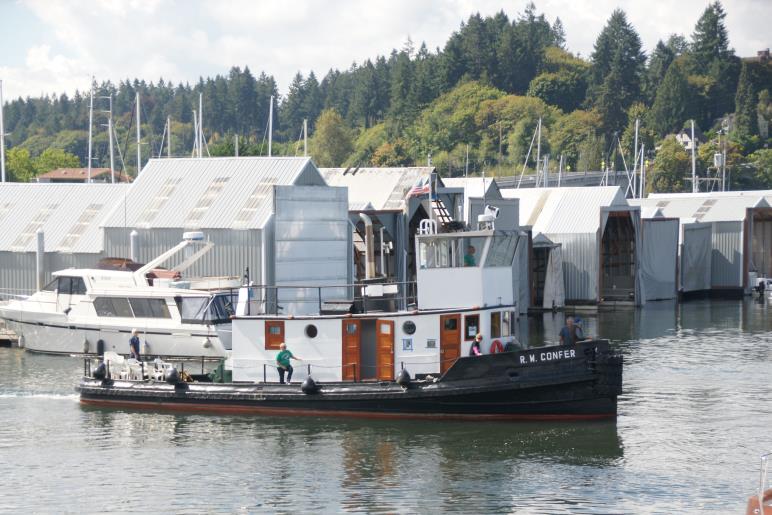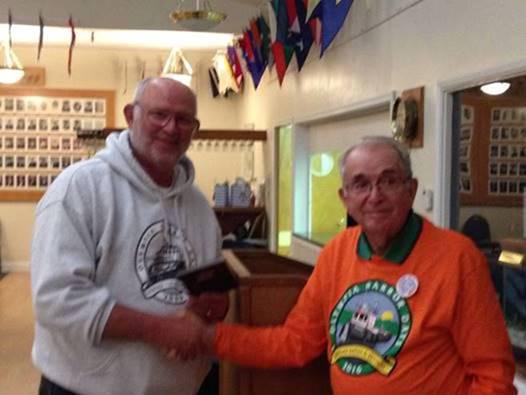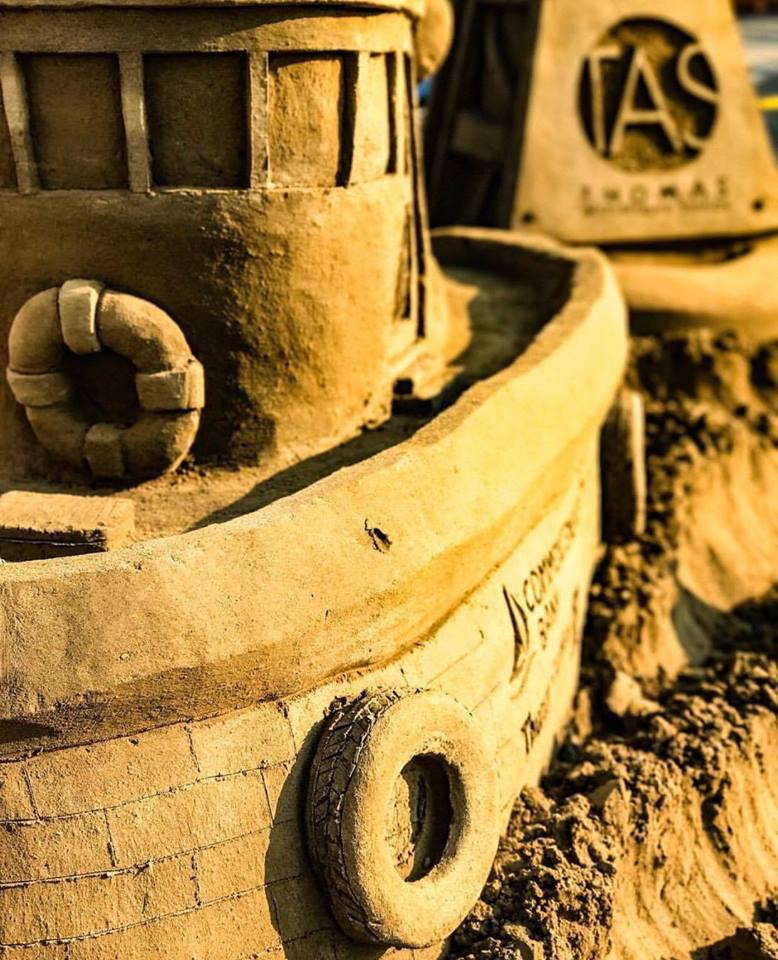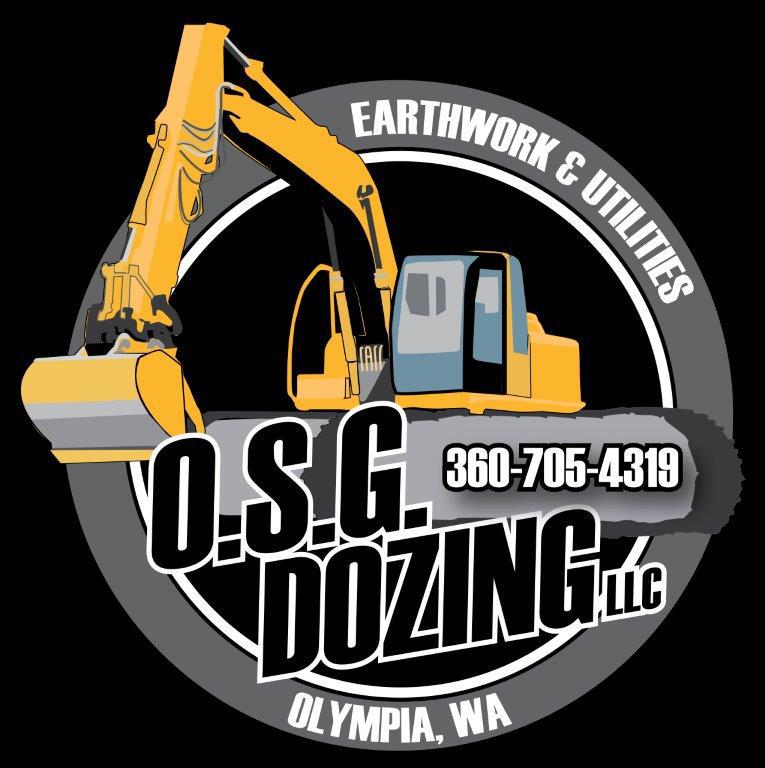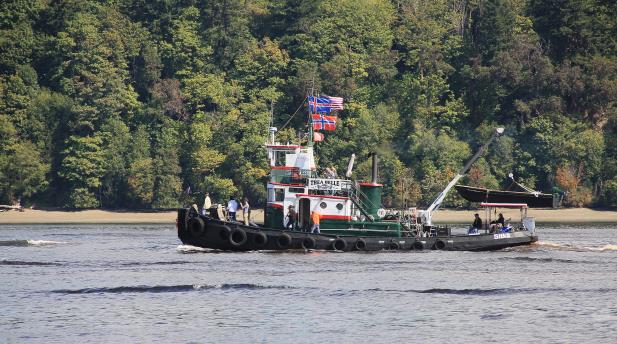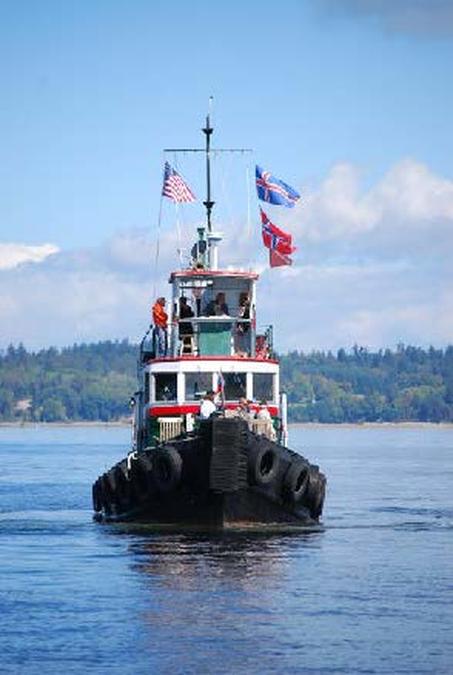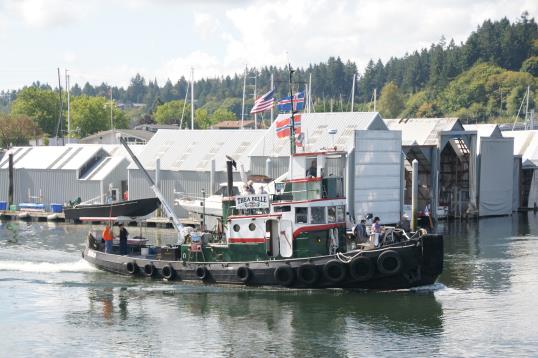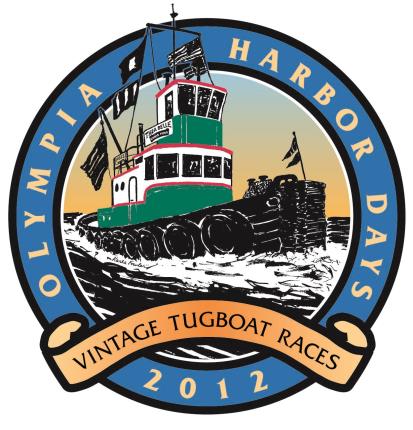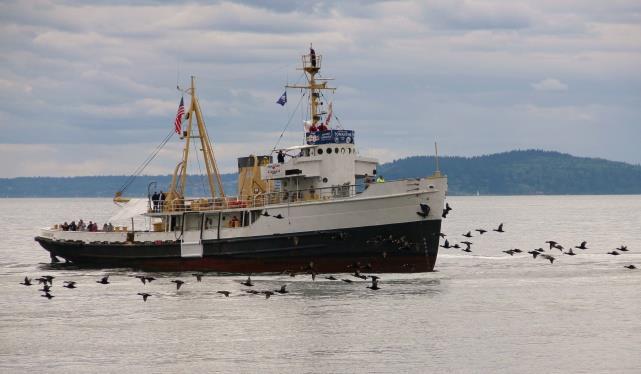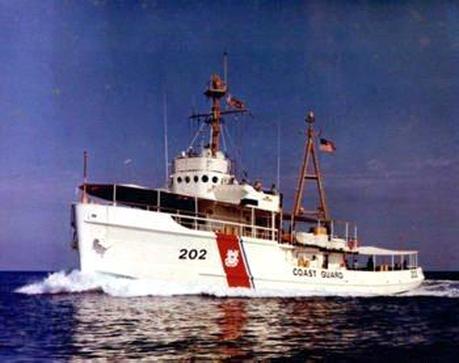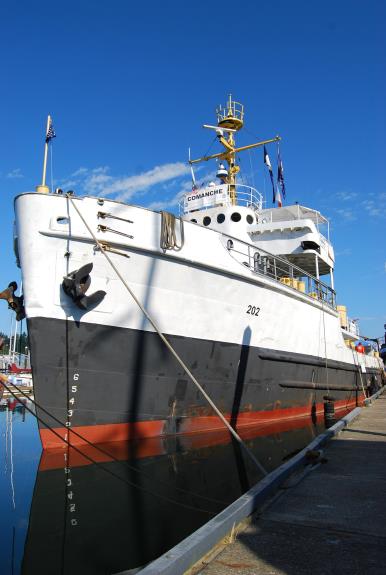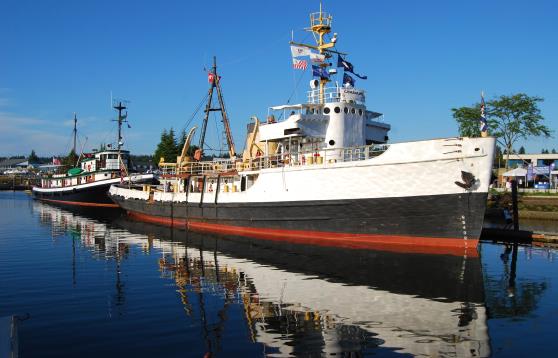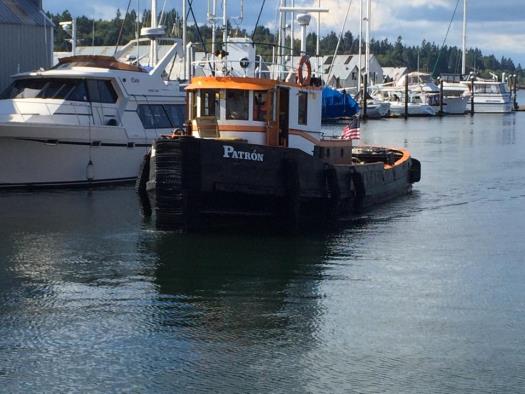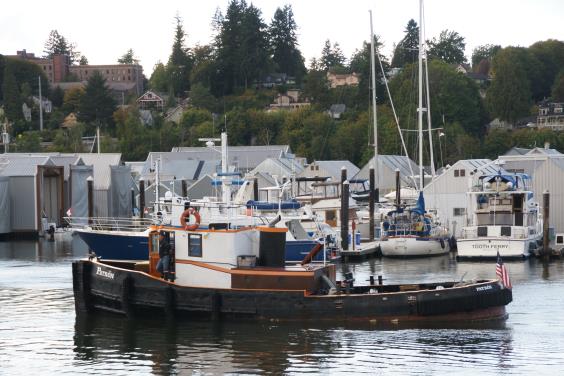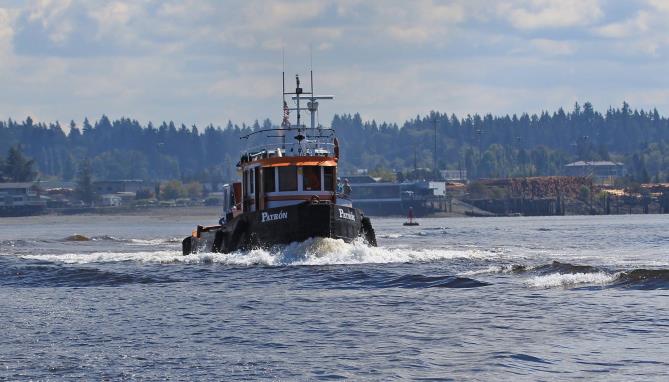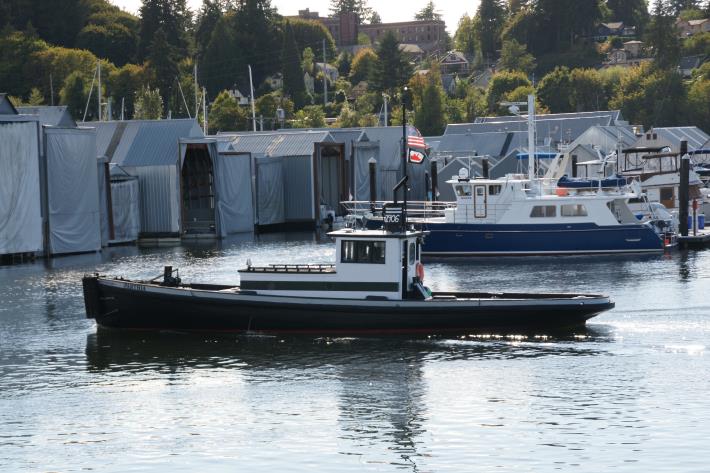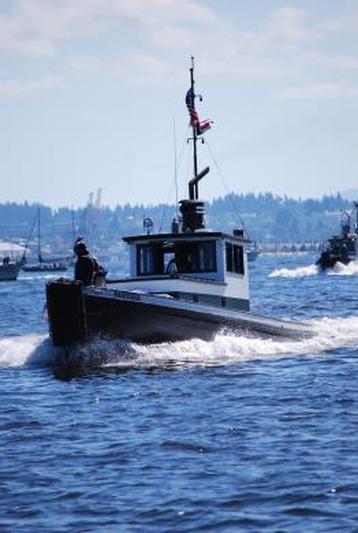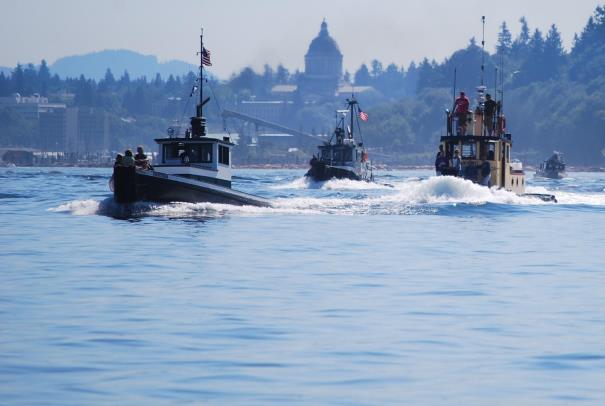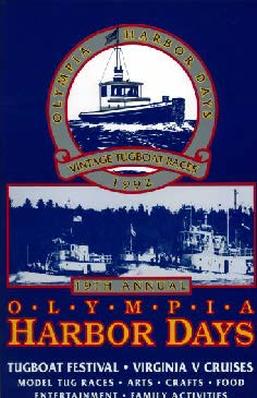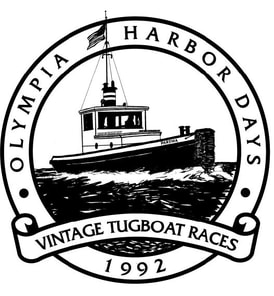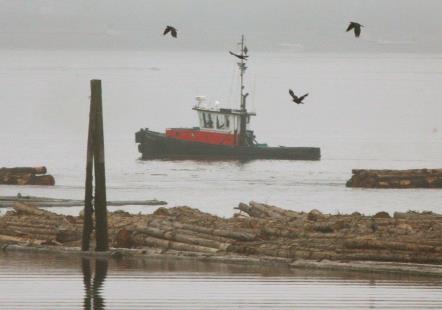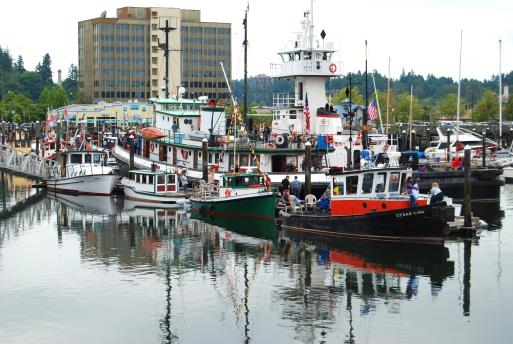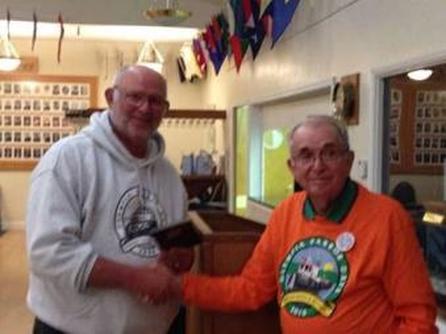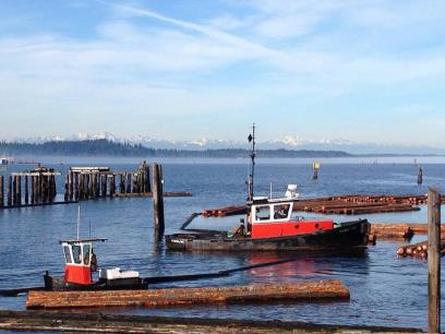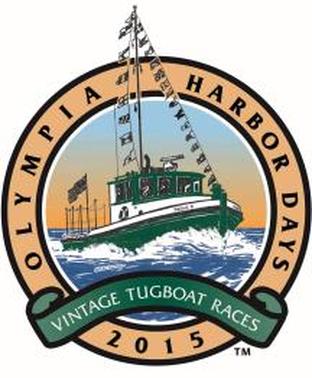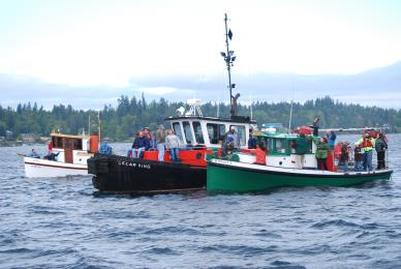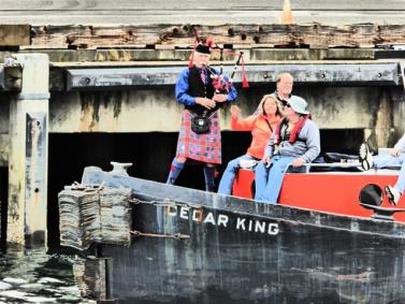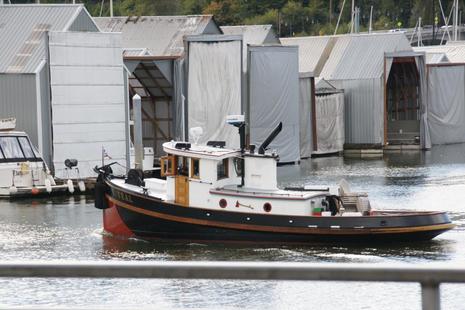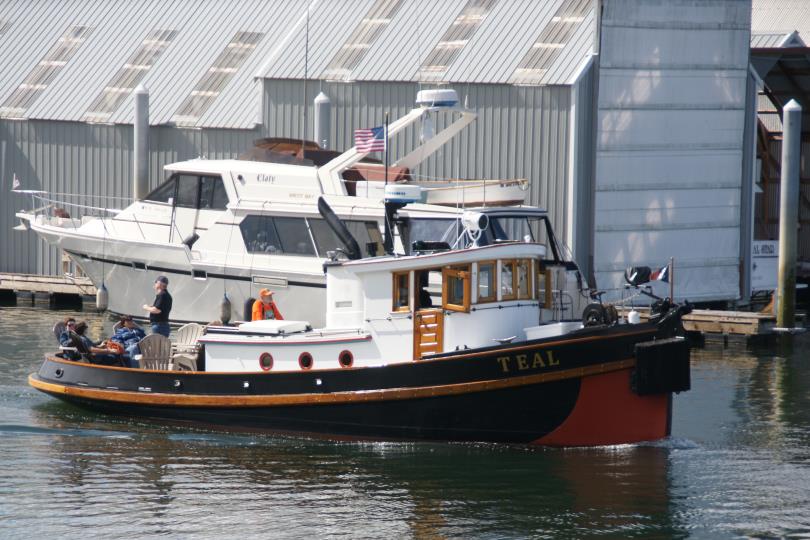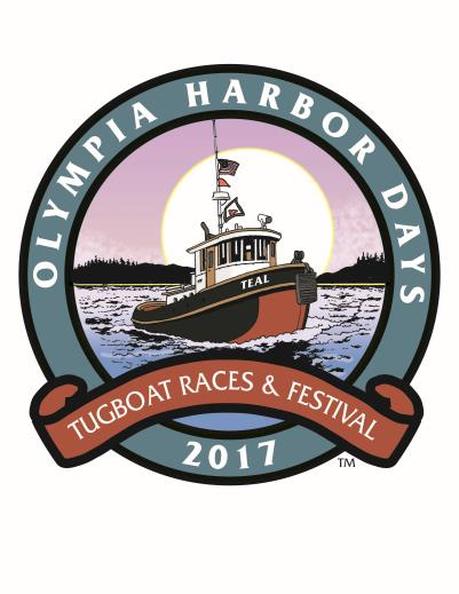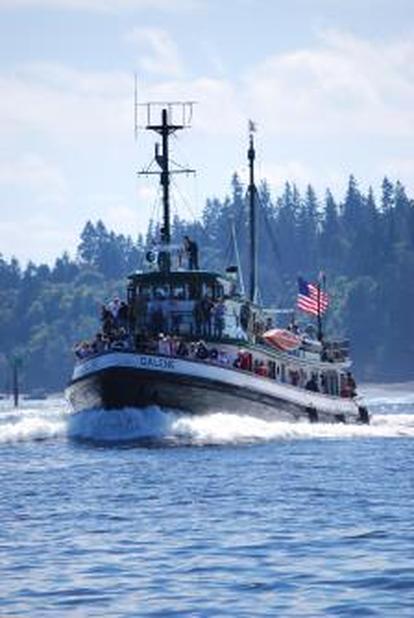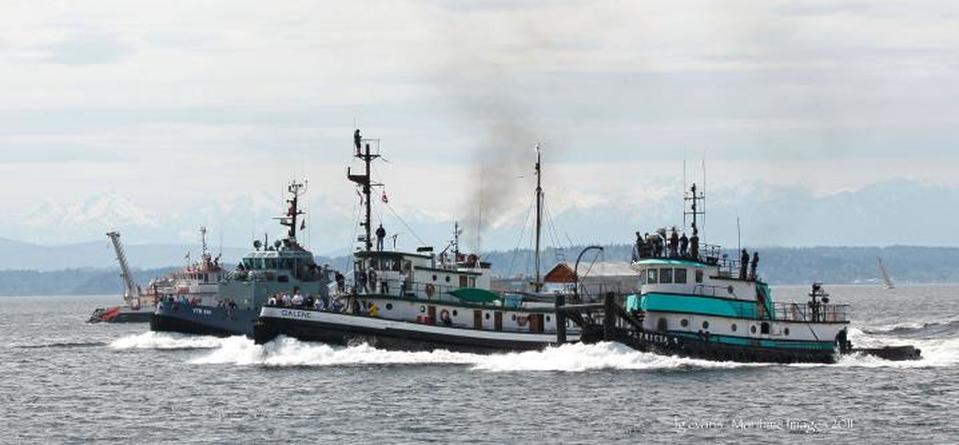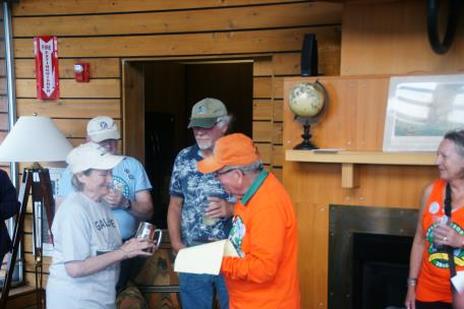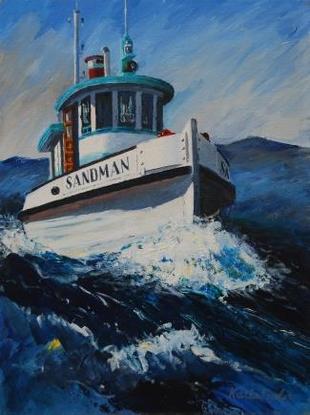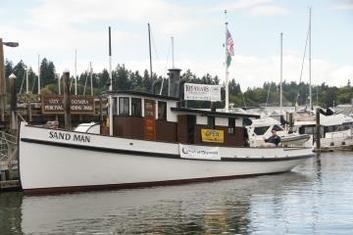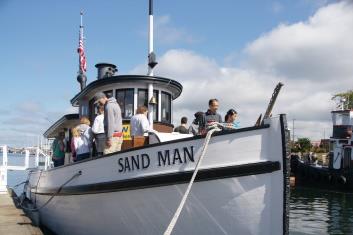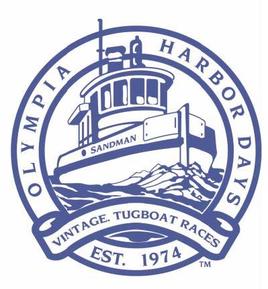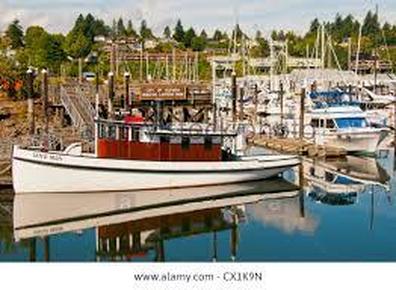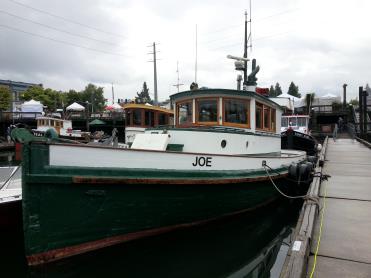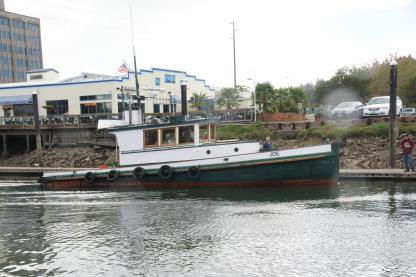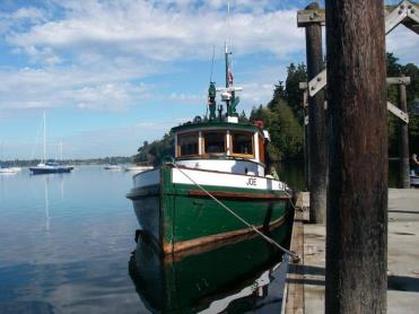by Les Eldridge
South Sound Maritime Heritage Association (SSMHA)
For
Olympia Kiwanis and Olympia Harbor Days
Based on “Tugboats on Puget Sound,” by Chuck Fowler and Capt. Mark Freeman,
Arcadia Publishing, 2009, available at bookstores, boating stores and other retail outlets throughout the Pacific Northwest
South Sound Maritime Heritage Association (SSMHA)
For
Olympia Kiwanis and Olympia Harbor Days
Based on “Tugboats on Puget Sound,” by Chuck Fowler and Capt. Mark Freeman,
Arcadia Publishing, 2009, available at bookstores, boating stores and other retail outlets throughout the Pacific Northwest
June 2019: RELIANCE
Tug RELIANCE ahead of Tug Cayou at Olympia Harbor Days 2011. Photo ©Karla Fowler.
|
RELIANCE was built in 1909 in Bay Center on the eastern shore of Shoalwater Bay (now, Willipa Harbor). She was built for the E.E. Case Logging Company, and was a log patrol and camp tender on the Washington Coast. There are more stories about the Reliance that people have told over the years, the most notable is that a Chinook Tribe member named Joseph George built the Reliance. In 1976, she was purchased by veteran tugboat skipper and owner Phil Shively, son of Otto Shively. Phil owns Shively Towboat Company of Seattle.
|
|
Shively bought RELIANCE in 1976, after many decades under many owners on the Washington coast, and began towing in Puget Sound. Her length over all is 40 feet. She was an active participant and competitive racer at Olympia Harbor Days (OHD) tug races and festival, winning her events in 1980, 1981, 1982, 1988, and 2011. She also raced in 1983, 1985, 1987, 1990, 2009, and 2011. Shively owned her in the earlier years, replacing her engine in 1980 which is still in service today. Pat Little was the registered owner from 1987 – 1990 period.
|
|
Her present owner, John Dierck of Allyn, WA, first raced her at OHD in 2009, but lost his hydraulic steering just before the start. In 2010, the year of Tug Sand Man’s 100th Birthday party, Dierck brought RELIANCE to Olympia and participated in a “staged TV race” against Parthia and ran out of fuel at the finish. Parthia towed RELIANCE to the dock. However, Dierck has this to add “I was headed to nearby Zittle’s Marina to get fuel when the real race between Reliance and Parthia happened. We were both passing Johnson Point about the same time and wound up racing to Olympia before "the staged race" when in fact, I did run out of fuel.”
He beat Parthia in the 2011 race, the year RELIANCE was Logo Tug. Dierck still loves Olympia Harbor Days and attend the Tugboat Show regularly but no longer races. |
Tug RELIANCE Logo Boat Cake. Photo courtesy of Karla Fowler.
|
Tug RELIANCE 2011 in Seattle. Photo courtesy of lg evans Maritime Images
Sources: OHD archives, The Olympian newspaper, John Dierck interview, Tugboats on Puget Sound by Fowler and Freeman, Arcadia Publishing.
May 2019: JANE B & CHAUNY C
The energy and determination of Dr. Robert Peck know no bounds. When we left his story in Volume I of “Tugs at the Capital City” (2018), he had just completed work on his third mini or scale tug, the JANE B. Here is her story, and that of his fourth mini tug effort, now a-building, the CHAUNY C.
Jane B with builder Bob Peck and Olympia Harbor Days attendee. Photo ©Karla Fowler.
JANE B is named for Bob Peck’s daughter-in-law. She is designed along the lines of an early 1900s Great Lakes harbor tug. This replica is twelve feet long, with a beam of five feet, six inches, and draws eighteen inches. She is powered by a twelve horsepower Volvo engine.
|
Jane B bow view. Olympia Harbor Days Photo Collection, Shanna Paxton Photography.
|
Mini Tug Jane B decked out for the holidays. Photo courtesy Bob Peck.
Most of the harbors of the Great Lakes are located at the mouths of rivers. As a result, a distinguishing feature of the Great Lakes tugs is their low pilot house, so they can go under low bridges. The earliest ones were steam-powered, with a tall smoke stack for “draft.” The many bridges made a hinged smoke stack necessary so it could be lowered. These tugs pulled only, and did not push, consequently, they have no fenders on the bow for pushing. They were used in Great Lakes harbors, and up the canals and rivers that flowed into the lakes.
Great Lakes tugs were broad of beam, and their tow bitts were cleats on each side of the pilot house, to reduce the lift of their sterns by their tow ropes when they towed the high-prowed lakes vessels. They needed to be highly maneuverable, and so steered with a short tiller bar inside the wheel house, rather than a wheel. Each had a pronounced sheer, that graceful rising curve of the bulwark from aft to forward, and they had very high prows. Dr. Peck notes that “they could pull anything that floated, and go anywhere required. This marriage of the beautiful with the utilitarian is seldom better done than with the Great Lakes harbor tugs.” JANE B made her inaugural Olympia Harbor Days appearance in 2018. Jane B at Percival Landing, Olympia WA.
|
CHAUNY C.
This vessel, under construction as of 2019, is named for Bob’s wife, whose given name is “Charlene,” and whose nickname is “Chauny.” This mini tug is a scale replica of a Danube River towboat. These craft can be seen all along the Danube, from the headwaters to the Black Sea. Bob mentions that a distinguishing feature of these “sassy” ships is that they include family living quarters. They are individually owned and operated and provide the home for the owner’s family. An intriguing characteristic is children’s toys and family gear piled on the after deck, including bicycles. Hand railings along the sides support canvas covers to keep small children from falling overboard.
These work boats range from 40 to 75 feet in length and are very broad of beam. The after deck is small, as is the working foredeck. They carry a few fenders along the sides, but none on the prow. Bob’s scale replica is twelve feet in length, with a five foot, eight-inch beam, and draws 20 inches. CHAUNY C will be powered by a three-cycle, 27 horsepower Universal Diesel engine.
Without a doubt, Bob’s fascination with boats and boatbuilding far exceeds the label of “hobby.” It is beyond a craft, it is a calling.
Sources: “Tugboats and the Sea” by Robert Peck, 2017. Interview with Bob Peck, 2018. “Tugs at the Capital City” by Les Eldridge, 2018.
These work boats range from 40 to 75 feet in length and are very broad of beam. The after deck is small, as is the working foredeck. They carry a few fenders along the sides, but none on the prow. Bob’s scale replica is twelve feet in length, with a five foot, eight-inch beam, and draws 20 inches. CHAUNY C will be powered by a three-cycle, 27 horsepower Universal Diesel engine.
Without a doubt, Bob’s fascination with boats and boatbuilding far exceeds the label of “hobby.” It is beyond a craft, it is a calling.
Sources: “Tugboats and the Sea” by Robert Peck, 2017. Interview with Bob Peck, 2018. “Tugs at the Capital City” by Les Eldridge, 2018.
April 2019: Elf
With special thanks to the late John W. Hough, maritime historian for his research and insights.
The steam tug ELF was built in 1902 for Olson Towing Company by the highly-respected Tacoma shipyard Crawford and Reid. She towed logs, barges, and did salvage work living up to her name. Her crew quickly earned a reputation as one that had fun together, and that often played pranks on other crews.
The steam tug ELF was built in 1902 for Olson Towing Company by the highly-respected Tacoma shipyard Crawford and Reid. She towed logs, barges, and did salvage work living up to her name. Her crew quickly earned a reputation as one that had fun together, and that often played pranks on other crews.
Tug ELF, Olympia Harbor Days 1988, Photo ©Karla Fowler.
|
In 1916, she was sold to Foss Launch and Tug Company, with two other Olson boats, the Olympian and the Echo. This transaction marked Foss Company’s change from a launch enterprise to a true tug and towing company, owning as many as 70 tugs. The Company name changed from Foss Launch to Foss Launch and Tug and today is known as Foss Maritime.
In the early 20th Century, Crawford and Reid was the ‘gold standard” among Puget Sound shipyards. Their vessels were known for their speed and sturdy structure. They built many tugs, but were primarily known for their passenger steamers, the best of the “Mosquito Fleet.” If you wanted a faster boat, you went to Crawford and Reid on Commencement Bay. ELF was powered by a D386 Caterpillar Diesel engine generating 360 horsepower. She was 63 feet long, with a beam of 15.9 feet and a 6.5 foot draft. After Foss purchased and renamed her, she continued her dependable service for several decades as Foss #15 until her resale to Olson Towing, when she was renamed Karlyn. The tug was then sold to Steve Tate, owner and operator of Tate Towboat, who renamed her Skookum Cache. Later, when the name ELF was no longer being used by another vessel, Steve returned her to her original name, the ELF. She worked on the construction of the submarine base at Naval Station Bangor, on Hood Canal. Tug ELF was listed for sale, year unknown, as a “1902 Crawford and Reid Pilothouse Diesel Tugboat.” A listing for her with exterior and interior shots can be found at http://www.luxuryatch.com/1902-crawford-and-reid-pilothouse-diesel-tugboat/. Tug ELF hauling the Pansa through the Thea Foss Waterway, formerly City Waterway. Marvin Boland Photographer.
|
Tug ELF, Tacoma (no date). Photo courtesy of Puget Sound Maritime Historical Society and Mike Skalley.
|
|
On August 16, 1989, she was acquired by Karen and Earl Van Diest of Tacoma and the name ELF was retained. That same year, ELF had the honor as the Olympia Harbor Days Logo Boat (aka Flagship), the oldest vessel that had participated the prior year and had not been selected before. The same criteria are still used today. This was the same year that Foss Maritime Company celebrated their centennial as part of the statewide Washington Centennial of Statehood Celebration.
|
ELF’s involvement in Olympia Harbor Days (OHD) and its vintage tug races was extensive. She was a frequent participant and won her class race in 2002. Her participation in tug racing began long before OHD. She raced other tugs on April 24, 1938, at the Tacoma Marine Carnival (Marfest) near Point Defiance Park.
Foss #15 (ELF) Tacoma Marfest 1938. Photo courtesy of the Mike Stork Collection.
Tug ELF with rafted tugs at Olympia Harbor Days, late 1980s. Photo ©Karla Fowler.
The tug continued towing until January 2018, when she inexplicably sank near West Vancouver, B.C., while towing a barge. ELF sank in 360 feet of water in Queen Charlotte Channel near Passage Islands off Point Atkinson and the West Vancouver Park light, at the mouth of Burrard Inlet. There are no plans to raise her.
Olympia Harbor Days regrets her sinking and her absence from the festival.
Sources: Crawford and Reid by John W. Hough, Sea Chest Magazine, 2010. www.tugboatinformation.com, by Craig Verrastro, 2019. Foss Maritime Company by Mike Stork, Arcadia Publishing Co., 2007. Conversations with Michael Skalley, author Foss: Ninety Years of Towboating, Superior, 1981.
Olympia Harbor Days regrets her sinking and her absence from the festival.
Sources: Crawford and Reid by John W. Hough, Sea Chest Magazine, 2010. www.tugboatinformation.com, by Craig Verrastro, 2019. Foss Maritime Company by Mike Stork, Arcadia Publishing Co., 2007. Conversations with Michael Skalley, author Foss: Ninety Years of Towboating, Superior, 1981.
March 2019: DANNI K
DANNI K was built in Seattle in 1916 by Alex Callerm for the Snohomish River Boom Company of Everett, WA. Originally named the George S., she boomed and towed logs out of the Swinomish Slough (now the Swinomish Channel) for several years.
From 1959 to 1971, she changed ownership four times. In 1971, she was renamed the Millard T. Fillmore after the thirteenth president of the United States.
From 1959 to 1971, she changed ownership four times. In 1971, she was renamed the Millard T. Fillmore after the thirteenth president of the United States.
Tug DANNI K. on the Ship Canal in Ballard, WA. Photo courtesy of ©lg Evans Maritime Images.
|
The tug Fillmore was purchased by Albert Freeman in 1973. He stored her, unused for 40 years, in covered moorage on the shores of West Lake Union, Seattle, WA, and sold her in 2013. In 2016, the present owner, Dan Cadman, bought her and renamed her DANNI K, after his granddaughter.
DANNI K is 36 feet in length, with a beam of eleven feet and draws five feet. Her hull and decks are steel-clad. Her original 32 horsepower gasoline engine was replaced in 1957 by a war surplus Grey Marine 671 General Motors Diesel airshift, also known as a “Screamin’ Jimmy”, originally designed for US Military water craft and tanks in WWII. This two cycle engine generates 165 horsepower, with redundant fuel filtering and bilge pumping capacity. DANNI K raced in the Small Tug category in the 2017 and 2018 Olympia Harbor Days vintage tug races. As she was the oldest tug in the 2018 event, that had not previously been selected as a logo tug, she was bestowed the honor of Logo Tug for the 2019 Olympia Harbor Days Tugboat Festival and Races where dock side tours of the tug are offered. Skipper Dan Cadman now uses the tug as a pleasure craft and offers harbor tours and light towing work. Tug DANNI K is moored at Quartermaster Harbor, Vashon Island, WA. Contact [email protected] for tour information. Sources: Interview with Dan Cadman, 2017, 2018. West Coast Workboats, Archie Satterfield, Sasquatch Books. Ships of the Inland Sea, Gordon Newell, Binford and Mort. Tug DANNI K at Olympia Harbor Days, 2018. Photos ©Karla Fowler.
|
April 2018: SMITTY J and KATHY M … and boat builder Bob Peck
|
Bob Peck has long been a pillar of the Olympia Harbor Days (OHD) enterprise, and his scale or mini tugs have been a prominent feature in recent years. Two are completed, and a third is under construction.
Smitty J, the first boat built (2003), was named for Bob’s first wife, the late “Smitty June” Peck. She is 10 feet in length, with a 13 horsepower gas engine, and is an East Coast harbor tug design from the 1920-30s. The cabins had to be built larger than scale to accommodate the engine. Stability at the dock was also a consideration. As Peck says in his excellent boat-builder’s memoir, Tugboats and the Sea (2017), the hull is built wider than in a full scale boat and the dead rise (the slope of the under-water sides to the central keel) is almost flat. Smitty J and Kathy M at Olympia Harbor Days 2015 (photo courtesy of Karla Fowler)
|
|
Peck donated Smitty J to the Olympia Kiwanis Club in 2012 to be used promotionally in support of Olympia Harbor Days when responsibility for the festival and races was transferred from South Sound Maritime Heritage Association (SSMHA) to the Kiwanis. She is now a “shore-side” boat, appearing at the Capital Mall, displayed on Percival Landing during OHD, and also appears in regional festivals and parades, often towed by Kiwanian and former SSMHA president Dave Peeler.
Bob Peck and Smitty J on the water and at the docks (photos courtesy of Karla Fowler) Many of Smitty J’s features are identical to a full-scale tug’s. The aft underwater hull slopes up smoothly from just forward of the propeller to the water line at the stern, giving the boat additional buoyancy aft, an important towing feature, as the propeller wash moves directly up under the stern, rather than discharging to the sides.
|
|
Kathy M is 15 feet in length, powered by a Volvo 13.5 HP engine. She was built in 2004. Her design is that of a Pacific Northwest tug of the 1890s to the 1920s. She is named for Peck’s daughter. She appears at Percival Landing each OHD Labor Day weekend, in the water, secured to the dock and ready for public inspection. As Peck notes, he considers his work to be artistic, not in the “Mona Lisa” sense, but people do “ooo” and “ah.”
Kathy M with Bronc Tug Heart Strings (OHD Stock Photo)
|
|
His third scale tug, the Jane B, is under construction. Slightly larger than Kathy M she is named for Peck’s daughter-in-law. Her design model is that of a Great Lakes harbor tug of the 1950s.
Dr. Robert D. Peck, scholar/boat builder, has owned, built or remodeled more than 20 vessels in his lifetime. It seems a highly unusual practice for a self-described ‘egg-head.” Peck has been president of three independent universities and held leadership positions in both a state and national educational council. He holds doctoral degrees in Religion and Philosophy, and his forte’ is the history of ideas. It seems that this particular academic preparation has drawn him to a sensitivity concerning the mystery of the seas, with his boat building born of that mysterious feeling. Peck loves the creative nature of the building craft, the love of and knowledge of the wood, which wood works best for which hull segment, and the grace and beauty of the boat design, the sheer, for instance, that graceful curve of the deck line from fore to aft. He delights in puzzling over the origins of arcane sea traditions; the gilded eagle atop the deck houses of Eastern tugs, the reason for the narrow pilot houses (for economy, the skipper was also the helmsmen, and in New York harbor he had to be able to hold the wheel while reaching through the pilot house window for the note from the dispatcher of the location of his next tow). Kathy M (photos courtesy of Karla Fowler)
|
This verse Peck wrote explains as well as anything his fascination with the sea and the vessels it bears:
What is this will upon me laid
That I should find it so compelling
That no imagination can sunder
Nor parse beyond its clear delight?
It does not wither by day
Nor close by night
The dream is not of day or night
But is the inner rhyme of life.
As a varsity oarsman at the University of Washington, I sat for four years at the feet of another boat-builder/philosopher, George Yeoman Pocock. Peck’s observations remind me greatly of Pocock’s wisdom.
Peck’s OHD involvement has been central to the race and festival’s success. As a long time president of SSMHA, and still on its board, as a race judge, the traditional master of ceremonies for the Skippers Dinner, and race master advisor, no OHD weekend would be complete without him.
Peck is currently helping shaping the future of SSMHA’s Tug Parthia Project, and with historian Chuck Fowler, and restoration boss Gary Larson, we hope soon to display the Parthia ashore as a maritime heritage feature of the Olympia waterfront. Peck will be in the middle of this effort.
Sources: Interviews with Bob Peck. Tugboats and the Sea by Robert D. Peck, 2017. Tugboats on Puget Sound by Chuck Fowler and Capt. Mark Freeman, Arcadia Publishing, 2009. West Coast Workboats, by Archie Satterfield, Sasquatch Books, 1992.Tugboats Illustrated by Paul Farrell, W.W. Norton, 2016.
What is this will upon me laid
That I should find it so compelling
That no imagination can sunder
Nor parse beyond its clear delight?
It does not wither by day
Nor close by night
The dream is not of day or night
But is the inner rhyme of life.
As a varsity oarsman at the University of Washington, I sat for four years at the feet of another boat-builder/philosopher, George Yeoman Pocock. Peck’s observations remind me greatly of Pocock’s wisdom.
Peck’s OHD involvement has been central to the race and festival’s success. As a long time president of SSMHA, and still on its board, as a race judge, the traditional master of ceremonies for the Skippers Dinner, and race master advisor, no OHD weekend would be complete without him.
Peck is currently helping shaping the future of SSMHA’s Tug Parthia Project, and with historian Chuck Fowler, and restoration boss Gary Larson, we hope soon to display the Parthia ashore as a maritime heritage feature of the Olympia waterfront. Peck will be in the middle of this effort.
Sources: Interviews with Bob Peck. Tugboats and the Sea by Robert D. Peck, 2017. Tugboats on Puget Sound by Chuck Fowler and Capt. Mark Freeman, Arcadia Publishing, 2009. West Coast Workboats, by Archie Satterfield, Sasquatch Books, 1992.Tugboats Illustrated by Paul Farrell, W.W. Norton, 2016.
February 2018: R.W. CONFER; The Tug of the Month, Olympia Harbor Days Tug Races and Festival
R.W. Confer Racing at Olympia Harbor Days 2016 (Photo courtesy of LG Evans Maritime Images)
R. W. CONFER was built in 1930 in Portland, Oregon, by Albina Shipyards, Engine and Machine Works (founded 1900). Albina was later sold to Dillingham Ship repair. CONFER’s hull is an unusual design, unique to the Pacific Northwest towing community. It is a “tunnel hull,” with the outer parts of the hull bottom lower than the middle, for rudder protection. Albina shipyards specialized in the construction design and fabrication of tunnel hulls. The design also may provide the advantages of the European “hydro conic” hull design, ensuring maximum water flow around the propeller with the result of uniform wake and reduction of turbulence. This enables a larger propeller to be fitted and increases propeller efficiency, raising bollard pull by as much as 30%. It also increases ability to maintain speed in rough seas.
|
She towed logs on the Columbia River for 70 years, working for Tidewater Tug and Barge, and for Camas and Wauna paper mills. Western Transportation Company was her corporate owner, and she was christened October 13, 1930 by Roma Maxine Confer, 19-year-old daughter of R.W. Confer, Operating Manager of Western Transportation Company.
R.W. Confer Heading to the Olympia Harbor Days Vintage Tugboat Races 2016 (Family Photo furnished to OHD) |
|
R.W. Confer at Percival Landing, Olympia Harbor Days 2016 (OHD stock photo)
|
In 1998, the CONFER was due to be scrapped, but instead was purchased by Rex and Tana Hasart in 2000. She is currently home-ported in Seattle’s Ballard District, near the Hiram Chittenden Locks.
Rex and Tana are widely recognized for their strong commitment to the International Retired Tugboat Association (IRTA). Under Rex’s guidance, the Hasarts have aided 30 different community charities with fundraising assistance. The Hasarts have hosted many an IRTA potluck in different anchorages in Puget Sound. Their outgoing personalities has led to their unofficial role at Olympia Harbor Days of new-boat greeters, making sure boats are properly and seamlessly rafted up and able to accept thousands of visitors. The Hasarts also provide advice on race protocols and scheduling to those new to the races and festival. The CONFER is always a center of renewed friendships and cleverly-spun yarns. |
|
R.W. CONFER is 61 feet in length with a 15 foot beam and she draws 4 ½ feet. Her original engine was an Atlas Imperial Diesel. She’s now on her third engine, a 3412 Caterpillar Diesel of 450 horsepower. To quote Rex, “…her restoration is never finished.” Rex has installed self-cooling pipes at the bottom of the hull, so all water aboard is self-contained and reusable to increase live-aboard capability and address environmental commitments.
R. W. CONFER was chosen as the 2006 logo tug for the Olympia Harbor Days (OHD) festival and tug races. She is a frequent participant in OHD races, in the “Over 400 HP” category. Often a second place finisher behind more powerful boats, and in 2017 she took first place in the “Large Tug” race. OHD looks forward to many more years of Hasart participation aboard R.W. CONFER. Sources: Tugs, Towboats and Towing, by Edward M. Brady, Cornell Maritime Press, 1967, interview with Rex Hasart, 2017, Tugboats and the Sea by Robert D. Peck, 2017. Interview with Bob Peck, 2016, Tugboats on Puget Sound by Chuck Fowler and Capt. Mark Freeman, Arcadia Publishing, 2009. |
R. W. Confer in Olympia WA (OHD stock photo)
January 2018: The Willie Family and Their Tugs; An Olympia Tug boating Legacy
|
Four generations of the Willie family of Olympia have been deeply involved in towing and tug boating history on Puget Sound. Milton Willie and a partner formed Olympia Towing Company in 1927. In the second generation, Gordon Willie led the company to specialize in sand and gravel barge towing, often using the quarry near Du Pont and Sequalitchew Creek, which later became Chambers Bay Golf Course. The quarry provided materials for the building of the State Capitol. Gordon’s tug Sunset won one of the early Olympia Harbor Days (OHD) races in 1976.
In the 1930s, the Olympia Towing Company fleet included tugboats Klatawa, Leonine and Nemah. By 1951, the fleet also included Crosmor, Christie R. and the ten-ton small tug Virginia. Third generation cousins Mac and Mike Willie split the operation, Mac running the towing end and Mike heading up sand and gravel operations. The company was sold in 1989 to Dunlap Towing of La Conner, Washington. This sale continued the traditional company relationship with OHD, as Dunlap Towing is one of the strongest supporters and participants in the annual Olympia Harbor Days races and festival. Their Olympia-based tug Cedar King, skippered by Gary Sanford, retired 2017, was a familiar sight on the Olympia waterfront, and a frequent winner in the OHD “Small Tug” race event. Sandford was given an award of appreciation in 2016. Fourth generation Brandy Willie continues the family interest in tugboating history. Brandy’s company, OSG Dozing, generously donated, delivered and removed the sand that was used by Form Finders for the sculpture of a tugboat featured at Olympia Harbor Days 2017. OHD Sand Carved Tugboat 2017 |
Gary Sandford and Bob Peck 2016.
|
July 2017: THEA BELLE, Olympia Harbor Days Tug Races and Festival.
|
Tug Thea Belle Courtesy LG Evans Maritime Images
|
THEA BELLE was constructed in City Island, New York for the US Navy in 1941 as YTL (Yard Tug, Small) 159. She sailed down the East coast and through the Panama Canal for Pearl Harbor to aid in the clean up after the December 7 Japanese attack. Next she was assigned to Puget Sound Navy Yard as a yard tug for the duration of World War II and until 1962. The Puget Navy Yard’s YTL’s helped several of the Pearl Harbor-attack surviving battleships as they limped back across the Pacific from Hawaii to Puget Sound for refit and repair. The West Virginia, Tennessee, Pennsylvania and California were all badly damaged, but when repaired, comprised the battle line at the 1944 Battle of Leyte Gulf at Surigao Strait, where the last of Japan’s surface navy was sunk. USS Tennessee was repaired twice at Puget Sound Navy Yard, and in 1943, with her added beam from more torpedo armor plating, was too wide to use the Panama Canal.
|
|
In 1962, Foss Launch and Tug Company bought YTL 159 from the Navy. She became one of the many dozens of Puget Sound tugs in the Foss fleet, bearing her new name, Chris Foss. We should not confuse her with the Christine Foss, a 1950s era Foss tug of
roughly the same tonnage, but whose engine generated 1380 horsepower, nor the Thea Foss, nor the first Chris Foss, a wooden tug still alive in Oregon. For twenty years and more, the Chris Foss towed log rafts and barges from Olympia to Juneau, Alaska, and everywhere in between. Foss sold her to a San Francisco tug company in 1985. In the Bay Area, she bore the names Goldstack, Coral, Sturdy, Benjamin, and finally, Belle, for as many different owners. THE PERILOUS VOYAGE OF CAPTAIN JIM: In 2007, Captain Jim Bennett made an offer on Belle and conducted a sea trial in San Francisco Bay, which he found unsatisfactory. A further year of negotiations led to his purchase of Belle in June 2008. The perilous voyage began. Jim and three friends cast off Redwood City, CA. for Puget Sound. About four miles outside the Golden Gate Bridge they encountered fog so thick they couldn’t see more than 200 feet ahead. Then, they endured a gale with 10 to 20 foot seas for the next seven days. No other ships were sighted. They sought shelter in Fort Bragg, CA, then in Eureka, CA, and finally in Newport, OR, each time entering at 2300 hours in the persistent fog, the swells, over the respective bars, past the jetties and safely into the harbors. They shipped green seas both night and day. The bilge pump never rested. Three huge truck tires used as bumpers were torn off the bow. Off the Washington coast near Neah Bay, the generator failed and they lost all radar and navigation systems. A passing tug contacted the US Coast Guard. The Coast Guard guided them to Neah Bay. The generator was repaired by a friend in Port Townsend, and they finally arrived in Port Orchard. As Jim says, “other than that, it was an uneventful trip.” Thea Belle Bow 2016. Photo courtesy Karla Fowler
|
Tug Thea Belle. Photo courtesy LG Evans Maritime Images
|
|
Photo from Olympia Harbor Days Collection
|
THEA BELLE still wears the Foss green and white color scheme although now under ownership of Jim Bennett. Extensive repairs modifications are ongoing. The THEA BELLE is 65 feet long, and draws nine feet, with a gross weight of 100 tons. Her V-8 Cat D379B cylinder diesel engine generates about 500 horsepower. She has a four cylinder Cummins diesel powering a 20KW generator. She now boasts a 5000-pound capacity crane. Engine repair, plumbing, rewiring, and compressor and fire pump replacement has taken place since Captain Jim’s purchase, to list just a few of the many completed refit activities. There is still a long list of tasks yet to accomplish. The refit has benefitted from the help of Jim’s many friends and supporters in Port Orchard, and up and down the Sound.
Thea Belle is unofficially on the market for sale as Jim’s stroke and arthritis have made the continual projects more difficult. |
|
An outside observer might guess that the tug’s present name reflects some of her heritage and history, ‘Belle” being her last name while in the San Francisco area, and “Thea” perhaps honoring her Foss years and the co-founder of Foss Launch and Tug Company, the energetic and irrepressible Norwegian immigrant, Thea Foss. Jim’s dad immigrated from Bono, Norway into Ellis Island in 1917 and his mother’s family came from Iceland. THEA BELLE has been a frequent participant in Olympia Harbor Days festival and tug races, noted for her sportsmanlike involvement. Jim often requests that THEA BELLE be moved to the Small Tug or the Harbor Tug category, rather than the Over 400 Horsepower race, so as to run at a more modest rate and reduce engine stress. In 2014, she finished fourth in the Over 400 HP race. In 2015, she was fourth in the same event, and in 2016, fourth in the Small Tugs race. Thea Belle’s six foot diameter, five blade propeller provides lots of power, but little speed.
Olympia Harbor Days 2012 Logo
|
Sources: Puget Sound Navy Yard photo and interview, Mike Napper, PSNY (Ret.), Jim Bennett interview, 2016, Sea of Thunder by Evan Thomas, Simon and Schuster, 2006, The Navy in Puget Sound by Cory Graff and Puget Sound Navy Museum, Arcadia, 2010, Ships of the Inland Sea by Gordon Newell, Binfords and Mort, 1960, Tugboats on Puget Sound by Chuck Fowler and Capt. Mark Freeman, Arcadia, 2009, West Coast Workboats by Archie Satterfield, Sasquatch Books, 1992.
June 2017: COMANCHE, Olympia Harbor Days (OHD) Races and Festival.
|
COMANCHE is the most recent US Navy or Coast Guard vessel to bear the name, a name that frames a storied nautical tradition. She was built by Gulfport Boiler and Welding Works of Port Arthur, TX in 1944, commissioned, and designated an ATA (Ocean Tug, Auxiliary) with no name, as USS ATA 202. She supported the Okinawa campaign in 1945 during WW II, and towed battle-damaged ships to Ulithi Atoll for repair, earning a Battle Star for Combat. At war’s end, she reported to Naval Base San Diego, and then to the Reserve Fleet’s Texas Group in Orange TX. In 1947, she was placed out of service, and in 1948, given a name, USS Wampanoag, ATA 202.
In 1959, she was loaned to the US Coast Guard as WATA 202, USCG Cutter COMANCHE. Ten years later, her transfer was made permanent. As a CG Cutter, she was home-ported at Morro Bay and San Francisco before being transferred to Corpus Christi, TX where she engaged in many of the same activities plus piracy patrols in the Caribbean. In the late 1960s she returned to the Pacific and was stationed at Eureka, Ca until her decommissioning in 1980. When at Eureka, COMANCHE gave the first ever notice of violation to a foreign fishing ship. COMANCHE was decommissioned in 1980, having won the Coast Guard Meritorious Unit Commendation and the Coast Guard Battle Efficiency ribbon. |
Photograph Courtesy ATA-202 Collection |
|
Photograph Courtesy LG Evans Maritime Images
|
Previous “Comanche’s” include the USS Camanche, a 200-foot long, 1300 ton Passaic-class US Navy monitor armed with two 15-inch guns in turret. During the American Civil War, in 1864, Camanche was disassembled, shipped from the East Coast to San Francisco aboard the sailing ship Ariel, reassembled and commissioned in 1865 specifically to guard the city and San Francisco’s US Mint from attack by the Confederate raider CSS Shenandoah. Shenandoah was in the Pacific, and planning such an attack when she learned of the Civil War’s end in August 1865, whereupon she headed to Liverpool on a 14,000-mile journey and surrendered the ship to the British.
|
|
Another “Comanche” was a 165-foot icebreaking Coast Guard Cutter of the Ossipee class, launched in 1934 and performing extensive convoy, anti-submarine and rescue duty throughout the duration of WW II in the North Atlantic including the heroic rescue and saving of lives when the troopship SS Dorchester of “the Four Chaplains” fame was lost. USCGC Comanche (WPG 76) was decommissioned in 1947.
COMANCHE is 143 feet in length, displaces 754 tons, and is powered by her original two General Electric GM diesel Cleveland 278A V-12 engines, powering her at 750 horsepower each. Her wartime complement was 47 men and in the USCG, 43. |
Photograph Courtesy ATA-202 Collection
|
|
After she was decommissioned, she served as a commercial tug from 1990 to 2001. In 2007, COMANCHE was given to the COMANCHE 202 Foundation, 403 Garfield St. S., Tacoma WA 98444. This occurred in Olympia and thus her USCG Documented Home Port is Olympia, WA. She is crewed and maintained by Foundation volunteers, and cruises Puget Sound, welcoming 3,000 to 5000 visitors a year, including many youth groups such as the Boy Scouts of America. She is being restored to her pre-1970s appearance, and can accommodate 25 overnight guests with two working heads, a galley, library, and museum spaces. 2017 is the tenth anniversary of COMANCHE becoming a museum ship. On board are several museum spaces, one dedicated to World War II with a special display about Pearl Harbor (75th Anniversary). A display of uniforms, which visitors are welcome to try on and a display about COMANCHE’s service as a Coast Guard Cutter.
COMANCHE has been a frequent participant in Olympia Harbor Days festival and races. Director of Operations Joe V. Peterson brought her to the, 2008, 2009, 2010, 2011 and 2013 events. Harbor Days was the first public open house for COMANCHE as a museum ship in 2008. Photograph Courtesy Karla Fowler 2013
|
|
COMANCHE is the most complete ‘as built’ ATA known, with original equipment now 73 years old. In 2014, she experienced trouble with her auxiliary electrical system, an expensive repair item. Efforts are still ongoing to raise the necessary funds for continued refurbishing of the auxiliary DC system and to rebuild the auxiliary generator. Some funds raised thus far have been from her many Olympia fans. She sent her crew (but not the tug) to the 2016 event. Visitors and Harbor Days volunteers alike are hopeful she’ll be able to participate in 2017. All contributions are tax deductible. Says Director Peterson, “We have plans to be there if all continues going well with the DC system. It’s our favorite event!”
|
Photograph Courtesy Karla Fowler 2013
|
COMANCHE is a member of the Historical Naval Ships Association, the Retired Tugboat Association, and Museum Ships on Facebook. Quite a bit of information and photos can be found at Tug Comanche Facebook site: https://www.facebook.com/COMANCHE202
The public can visit COMANCHE and even ride on her at no charge.
Sources: Civil War Navies by Paul H. Silverstone, Naval Institute Press, 2001. US Coast Guard History Program, www.uscg.mil/history/cutters. COMANCHE 202 FOUNDATION, [email protected], edits by director Joe V. Peterson.
The public can visit COMANCHE and even ride on her at no charge.
Sources: Civil War Navies by Paul H. Silverstone, Naval Institute Press, 2001. US Coast Guard History Program, www.uscg.mil/history/cutters. COMANCHE 202 FOUNDATION, [email protected], edits by director Joe V. Peterson.
May 2017: PATRÓN, 2016 Logo tug for the Olympia Harbor Days (OHD) Festival and Races.
|
PATRÓN is unusual, if not unique, in two aspects: She was purpose-built (for a specific project) and, after construction, she was cut into four sections so she could be shipped by railroad flat car to the project site, high in Washington State’s Northern Cascade Mountains. Further, she was first of her type on Puget Sound, designed by the noted naval architect and engineer H. C. Hanson of Seattle.
Hanson declared, with justifiable pride, that her steel construction at the Commercial Boiler Works of Seattle in 1937 combined “great strength and lightness with low cost,” like the well-known Hanson-designed steel barges. Photo Courtesy Olympia Harbor Days
|
|
Photo Courtesy Olympia Harbor Days
|
She was constructed for the General-Shea-Columbia Construction Company for work on Seattle City Light’s upper Ruby Dam, at the head of the Skagit River. The two dams at this mountain location, later named Ross and Diablo, formed Ruby Lake, later Ross Lake, a reservoir. She was built in five weeks, cut up, and reassembled at at the lake. After her years at the lake, her work there complete, she was disassembled, shipped back to the Seattle waterfront, reassembled, and made ready for more conventional towing duties.
PATRON’S length-over-all is 52 feet, with a 15 foot beam, and she draws six feet. She is still equipped with her original 160 horsepower Washington diesel engine. Her construction type mirrored the low-cost Hanson scows because of simplified design, welded steel construction and rapid completion, all designed to keep costs comparable to those of wood construction. PATRÓN later worked in Alaska on the Valdez oil spill, where she also refueled helicopters transporting logging camp workers in SE Alaska, by means of a helicopter landing pad mounted on her bow. |
|
Her skipper, Brian Parke, bought her from Western Tow Boat Company of Seattle in 2012. Western Tow Boat was founded in 1948 by Bob Shrewsbury, Sr. with a single tug, and now boasts 22 tugs and seven barges, many of them ocean-going tugs of more than 100 feet in length. Shrewbury’s son Bob and his grandchildren are now active in running the company, and the bright blue and yellow trimmed boats can be seen from Panama to Hawaii to Alaska, where the company partners with Alaska Marine Lines, and tows rail car barges to Whittier for Alaska Railroad. Occasionally, you’ll find them on their way to or from Alaska in the Inland Passage. Western Tow Boat is unusual among tug companies in that it has its own shipyard in Seattle’s Ballard district, and has for many years built its own boats.
As PATRÓN enters her eightieth year, her present skipper, Brain Parke, home-ports PATRÓN in Everett on the Snohomish River. He is an enthusiastic participant in Olympia Harbor Days Festival and Races, having entered PATRÓN in the Harbor Tug event in 2015 and 2016, where she finished fourth in a time of 12 minutes, 2 seconds. She can frequently be found at maritime events and celebrations throughout Puget Sound. |
Patron Racing Photo Courtesy LG Evans Maritime Images
|
PATRÓN was selected as the 2016 OHD logo tug. The annual logo tug for OHD is selected based on participation and age. A tug can only be selected as a logo boat once. For a list of our logo boats please HarborDays.com. We look forward to many more years of Olympia Harbor Days encounters with PATRÓN.
Sources: Pacific Motor Boat Magazine, The Olympian Newspaper, westerntowboat.com, Tugboats Illustrated by Paul Farrell, W.W. Norton, 2016.
Sources: Pacific Motor Boat Magazine, The Olympian Newspaper, westerntowboat.com, Tugboats Illustrated by Paul Farrell, W.W. Norton, 2016.
April 2017: PARTHIA, 1992 Logo Tug for the Olympia Harbor Days Festival and Races.
|
The venerable tug Parthia was built in Winslow, Bainbridge Island, Washington by James Hall in 1906. She towed for the Pacific Tugboat Company in 1910, and was then owned by a man named Lermond in 1912. At this time, she had a 50 horsepower gasoline engine, later increased to 75 horsepower.
In 1934, she was purchased by the prominent tug company owner Delta V. Smyth of Olympia, and she joined his six-boat fleet, which included the tug Sand Man. She was listed by Gordon Newell in his “Ships of the Inland Sea,” as boasting an 80 horsepower engine in 1951. In 1961, Smyth Tug and Barge Company sold her to Foss Launch and Tug Company, the largest towing firm on Puget Sound. Her Smyth Company consorts were also bought by Foss, including Audrey, Hoonah, Oysterman, and Rufus. They were painted the Foss green and white, but retained their Smyth names. |
Parthia arrives at Olympia Harbor Days 2016, photo courtesy of Olympia Harbor Days
|
|
In 1965, towing for Foss, she ran aground near Priest Point, Budd Inlet, while towing a raft of logs. According to reports, the skipper had fallen asleep at the wheel. Log raft towing, particularly against the tide, could be a boring enterprise with the tug and tow making only two or three knots over the ground. The Foss tug Rufus put a line aboard Parthia and towed her off at high tide.
In 1975, Foss sold her to Steve Moen, who converted her to a fishing vessel. In 1977, Gary Sanford, now skipper of the Dunlap Towing Company tug Cedar King, bought her and she reverted to a tug. In 1992, owned by Scott Bokland of Burton on Vashon Island, she was named Logo Tug by Olympia Harbor Days Races and Festival (OHD). She is 50 feet length over all, with an eleven foot beam, and draws 4’9 feet of water. Parthia Races Olympia Harbor Days 2012, photo courtesy of Karla Fowler
|
|
Parthia has been a frequent competitor in OHD races, winning the Small Tug race in 2016 over Ranger, Joe, and Teal. Prior OHD appearances included 1997 as well as a 2005 win over Marlin II and Earnest. In 2009, Parthia and R.W. Confer were unable to catch Olmsted in the OHD Small Tug event.
The Seattle Maritime Festival tug races, no longer being held, saw a triumph for Parthia in the Class C event in 2009, and a second place finish in that event in 2008, losing to Olmsted which finished in 7 minutes, 44 seconds. Not only did Parthia win her race at OHD in 2016, she was sold by her 11-year owner, George Hill, of Vashon Island. Her purchaser was Robert’ Shashinda of Pleasant Harbor near Brinnon on Hood Canal. Mr. Shashida is a collector of wooden boats, and formerly lived on Alameda Island in San Francisco Bay. His collection includes two sailing dinghies, a 1934 motor-sailer, an 1895 sail-powered German coastal freighter, and a keel sloop. His Hood Canal home includes docks and a workshop, and he intends to do extensive deferred maintenance on Parthia including deck work, beam replacement, and shoring up the supports for a heavy bitt just aft of the pilot house. The result will be faithful to her original configuration, and ready for future Puget Sound events. Welcome to the northwest, Robert’! Tug Parthia in the lead OHD Races 2011, photo courtesy of Karla Fowler
|
Sources: The design and art works of Karla Fowler, “Ships of the Inland Sea” by Gordon Newell, “Tugboats on Puget Sound” by Chuck Fowler and Capt. Mark Freeman (Arcadia Publishing),
parthia.com/ships/parthia, The Olympia Newspaper, the Seattle Post-Intelligencer, interview with Robert’ Shashinda. |
March 2017: The history of the tug Cedar King, Dunlap Towing Company and the history of Olympia’s Willie family, owners of Olympia Towing, Co.
|
Cedar King is one of the most familiar tugs on the waters of Olympia’s Budd Inlet, usually seen moving log rafts from West Bay, and a frequent participant in Olympia Harbor Days’ annual tug races held each Labor Day weekend. She was built in 1970 by Reliable Steel of Olympia for the Olympia Towing Company, founded by Milton Willie in 1927 and run by the Willie family for three generations until its sale to Dunlap Towing of La Conner, WA in 1989. She is still a working tug for Dunlap Towing Company and West Bay Chip Reload, Olympia.
Photo credit: Olympia Harbor Days
|
|
Cedar King is 37 feet, 7 inches length-over-all, with a beam of almost 14 feet, and draws five feet, 7 inches. This 19-ton tug is powered by a 350 horsepower engine. She is skippered by Gary Sanford. Sanford and Cedar King were recognized at the 2016 Skippers Dinner, sponsored by Lucky Eagle Casino, for their years of volunteer service to the annual Olympia Harbor Days Tugboat Races, now celebrating 44 years of maritime history.
Photo credit: Karla Fowler, copyright 2012
Photo credit: Karla Fowler, copyright 2012
|
|
Her towing lineage for Dunlap and Olympia Towing is remarkable. Olympia Towing numbered fewer than a half-dozen tugs in 1951. It specialized in sand and gravel towing under the second generation, Gordon Willie. His tug Sunset won one of the very early Olympia Harbor Days races, in 1976. Third generation cousins Mike and Mac split the operation, Mac running the towing end and Mike heading up sand and gravel operations.
The 1989 sale of the towing company to Dunlap Towing of La Conner engendered significant growth to the “down-Sound” company. Gordon Newell’s “Ships of the Inland Sea” lists seven tugs owned by Dunlap in 1951. Today the company boasts 22 tugs, including Cedar King, and tows in Alaska waters and up and down the Pacific Coast, moving logs, oil, containerized cargo and assisting large ships. Dunlap is a long-time strong supporter of Olympia Harbor Days. Among Dunlap’s tugs is one of the most unusually named boats on the coast, the Pull and Be Damned. The name is an old rowing command from the eighteenth century. More information about Dunlap Towing can be found at http://www.dunlaptowing.com. Photo credit: Olympia Kiwanis Club, copyright 2016
Photo credit: Olympia Harbor Days |
|
In the 2016 Olympia Harbor Days race completion, Cedar King won the “Small Tug” event with a time of 11 minutes, 12 seconds over three other tugs. I believe her best performance occurred in the 2015 “Small Tug” race, when her skipper Gary Sanford and his wife Anita displayed the ultimate in good sportsmanship. Competing that year were Cedar King, Atka, skippered by Alan Glaser, noted boat designer and former South Sound Maritime Heritage Association member, and Maggie B, skippered by Michael “Tug” Buse, clearly the sentimental favorite.
In 2014, Tug Buse’s dad, Mike, a frequent winner in the Small Tug category, brought Maggie B up-Sound toward Olympia for the races when he suffered a stroke, was hospitalized, and died a few days later. Mike had always dreamed that Maggie B would be chosen as logo tug for the race event. In 2015, she was named logo tug, and son “Tug” Buse, with his mother Penny, looked forward to racing and memorializing Mike during the race. |
|
Maggie B was leading Cedar King and Atka in the last 200 yards of the 2015 race when her engine blew.
Cedar King and Atka stopped immediately, Gary Sanford secured Maggie B to Cedar King’s starboard side, and with Atka escorting, pushed her over the finish line, making sure she was in first place! What sportsmanship! What “tugmanship!” Photo Credits Karla Fowler, copyright 2012 As Maggie B crossed the line, Penny scattered Mike’s ashes and some rose petals on the water as a bagpiper aboard played “Amazing Grace”. It was a truly memorable moment.
Photo credit: Drew Phillips |
Sources: “Ships of the Inland Sea” by Gordon Newell, “Tugboats on Puget Sound” by Chuck Fowler and Captain Mark Freeman, (Arcadia), The Olympian Newspaper, interview with Mike Willie.
February 2017: TEAL, 2017 Logo Tug for the Olympia Harbor Days Festival and races.
|
Teal was built in Blaine, Washington in 1949 for the Alaska Packers Association, the last of their wooden tugs. She was designed by the noted naval architect Edwin Monk, Sr. and his equally respected partners, brothers William and Lorne Garden. This traditional Northwest Coast tug ranged from Alaska to Olympia for the Packers and later for the Tacoma Tugboat Company, in both the salmon fishing industry and the logging industry.
Teal’s design is remarkable. She is described as deep draft, round bilge, plumb stem, elliptical fantail stern workboat, Lorne Garden and Ed Monk’s design number 1500. She was originally powered by an Atlas four-cylinder diesel, which has been replaced by a 1962 Caterpillar diesel engine, freshwater cooled, generating 300 horsepower. The engine change greatly increased her cabin space. Her screw is a 56’ X48” 4-blade wheel. She is 42 feet long and draws 7.6 feet. |
|
Ed Monk’s designs were very popular in the mid-20th Century and still in great demand. He and the Garden brothers designed many tugs, but were more well known for their cabin cruisers. A treasured Monk-designed vessel with cabin cruiser lines is the Tarry Not II, one of the last two “Mosquito Fleet” steamers still in operation. Built in 1926, she carried freight and passengers from Shelton to Olympia and intermediate stops, as well as some beach-logging towing. The 28’ vintage vessel is now owned by Steve Wilcox of Sea Blossom Seafoods in Olympia.
Monk tug designs, including Teal, are known for their graceful sheer, the fore and aft upward curve of the hull at the bulwarks or deck level. |
During her work for Alaska Packers, Teal ranged from Chignik, on the Alaska Peninsula, to Ketchikan and south to Birch Bay, Washington. She is sometimes homeported at Southworth on the Olympic Peninsula, and is now at the Port Orchard Yacht Club. She still ranges as far as Alaska.
Teal’s racing history is noteworthy. The late Captain Mark Freeman, in his book Tugboats On Puget Sound (co-author Chuck Fowler), shows a Captain Scott Schoch photo of Teal and Winamac racing in a 1980s Olympia Harbor Days tug race (page 111). She has taken a first place in her class at the Tacoma Maritime Festival Tugboat Race, and in 2016, placed third in the Small Tug race at Olympia Harbor Days.
Teal’s racing history is noteworthy. The late Captain Mark Freeman, in his book Tugboats On Puget Sound (co-author Chuck Fowler), shows a Captain Scott Schoch photo of Teal and Winamac racing in a 1980s Olympia Harbor Days tug race (page 111). She has taken a first place in her class at the Tacoma Maritime Festival Tugboat Race, and in 2016, placed third in the Small Tug race at Olympia Harbor Days.
|
She was recently selected as 2017 Olympia Harbor Days “logo tug” for the upcoming festival and races presented by Olympia Kiwanis. To qualify, she was the oldest “non-logo” tug participating in the Harbor Days races in 2016.
Previous to current owner Jan Carlson, Teal was repaired and restored in Tacoma by Jon and Pat Kent of CA, and before that was owned by Don Leonard of Tacoma, and the Alaska Packers. Congratulations to Teal on her selection as Olympia Harbor Days 2017 logo tug! |
Sources: Tugboats Illustrated by Paul Farrell, Norton, 2016, Tugboats on Puget Sound, by Chuck Fowler and Captain Mark Freeman, Arcadia, 2009, edmonkwoodenboatclub.org, Ships of the Inland Sea by Gordon Newell, Superior, 1960.
January 2017: the history of the Galene and the “Miki” tugs of the US Army Transportation Corps
|
The Galene is one of only a few surviving tugs from the 61 “Miki” class tugs of the US Army Transportation Corps, a Large Tug (LT). Fifty-one Miki class tugs were built at many west coast and local yards, including Grays Harbor, Washington. Galene, originally LT 464, and her four sisters were built in 1943 at Northeast Shipbuilding Company of Quincy, Massachusetts. Ten of the wooden Miki-class boats were built in eastern US shipyards. Only three tugs of the class are operational today.
LT 464 towed targets for the Navy in WW II, accompanied convoys in the Atlantic as a rescue tug, and left government service in 1954. Her 1200 horsepower (HP) Superior Diesel engine drives her 400 tons powerfully through the seas. She is 127 feet in length. She is one large tug! |
Photo courtesy Linda Evans
|
|
“Miki” in the Hawaiian language means “quick, active, prompt, fast and efficient in work.” To double such a noun/verb, as in “miki-miki,” means “very quick, very active,” which is also slang for a twin engine “Miki.”
Her lineage is remarkable. The WW II Army Transportation Department is the direct descendant of the Union Army’s Quartermaster Corps in our Civil War. In that war, the Union Navy grew to 700 vessels, the Confederate Navy to 500, but the Army’s Quartermaster Corps numbered more than 2000 vessels. It was the Army’s navy. The Corps’ ships transported food, horses, forage for the cavalry, ammunition, heavy ordinance, everything needed for the Army to fight among the thousands of river miles and winding inlets of eastern America, from the Atlantic coast and the Gulf of Mexico to the Mississippi River and the land beyond its western banks. Many Corps gunboats guarded their transports and were sunk or damaged in combat. That is a part of the Miki boats’ legacy! Courtesy Karla Fowler
|
Owners Skip and Marty Suttmeier found Galene in Portland, Oregon in 2007 and purchased her. Almost two years later, they had replaced, repaired or rebuilt almost everything aboard, and in August 2009, took her through a severe storm from Portland to Seattle, having engine trouble on the way. After some repairs, they travelled to Olympia in September for the 2009 Harbor Days races and placed second in the Large Tug event to the 1500 HP Judy M. They have been regular entrants at Olympia Harbor Days (OHD) ever since.
Courtesy Linda Evans
|
Galene was named the OHD logo boat for the 2013 races. She won her race that year and on just one day of festival visitors, logged 2000 people coming aboard. She won with a nonagenarian former crewmember on deck, Stan Wood, who had sailed as a 19-year-old deck hand during her Army days. The Suttmeiers had flown Wood out for the occasion from Belfair, Maine.
The Suttmeiers then reached out to a sister vessel, the 124-year-old Arthur Foss, to aid in “big tug” training for new crewmembers. On the way back from the races, Galene stopped in Tacoma to bring aboard five Northwest Seaport Foundation trainees who would later serve aboard the Seaport’s iconic Foss tug. Wood regaled them with tales of the old days aboard Galene as they trained as deck hands and engine crew on their way to Seattle. |
|
Galene won her OHD race in 2015 and 2016, as well. Her after deck is usually the scene of the pre-race skippers meetings for race instructions on rules and heats, and always the scene of lively banter among the dozens of skippers who gather there. She is a treasured participant at OHD.
Sources: NW Seaport.org, Tug Galene/About Galene, Civil War Navies by Silverstone. Graphics courtesy of OHD, Karla Fowler, and Linda Evans. 2016 Race Awards. |
December 2016: History of the Sand Man
|
In 1910, Sand Man was built at Crawford and Reid Shipyard, Tacoma, one of the premier ship builders among the many yards on Puget Sound. Arthur Weston, owner of Olympia Sand and Gravel Company, ordered the tug built in 1908. Weston provided essential construction materials by barge to Olympia and other South Sound sites from a rich deposit just north of Steilacoom. Sand Man towed these barges exclusively until her duties were expanded in the early 1920s to include towing log rafts and barges heaping with oysters.
Sand Man was first powered by a 50 horsepower “Frisco Standard” gas fed engine and a powerful 54” screw or propeller. When her loads increased in the 1920s, her engine was replaced by a 100 horsepower “Fairbanks-Morse” marine diesel. Her lines were not those of a conventional tug, with low freeboard aft for ease in line handling and the crew jumping back and forth from tug to log raft. Rather, she resembled a Whitehall pulling boat with graceful lines and higher freeboard aft. Nonetheless, she successfully towed for most of a century. |
Painting by Karla Fowler copyright 1983
|
The story is told that Weston lost all his boats except Sand Man in a card game, and, financially distressed, sold her in 1926 to Delta V. Smyth, Olympia tug fleet owner. Smyth’s seven boats were known as Capital City Towing, and sometimes, as the Smyth Tug and Barge Company. His fleet included the 1906 tug Parthia, still towing, and winner of the 2016 Harbor Tug race at Olympia Harbor Days. Smyth also owned the Audrey, converted from a freight and passenger “Mosquito Fleet” steamer to a towboat. The Smyth family, Delta’s son Wayne and grand daughter Sarah Smyth-McIntosh, are still integral players in the 44-year old Olympia Harbor Days Festival and Tug Races, originated by South Sound Maritime Heritage Association, and now sponsored by Olympia Kiwanis. It is the only such event left on the West Coast.
|
In 1944, Sand Man was fitted with her present engine, a 100 horsepower six-cylinder Caterpillar Diesel. In the 1950s the need for tugs in South Sound diminished, and Smyth sold most of his fleet to Foss. Sand Man he sold in 1953 to an Olympia man, Fred Chadwick, who in 1964 sold her to Franz Schlottmann who operated her until 1985, when Schlottmann retired himself and the tug. In 1987, Bob Powell of Olympia bought her, intending to convert the tug to an historic vessel. He and friend Paul Deranleau found her restoration a daunting task, as the tug had deteriorated badly. Soon, they formed the Sand Man Foundation, and began fundraising efforts. Against all odds, they secured the approval of Thurston County staff, who aided in an application for a Washington State Department of Transportation grant, and in 1999, she received a $300,000 grant. She sank twice on her way to Port Townsend for dry-docking, was raised, refitted, and spent eight years in attendance at maritime festivals throughout the Northwest. Since then, she has periodically struggled to keep her engine running consistently, and at present is secured to the dock at Percival Landing, unable to move. She is the official City of Olympia historic vessel, offering free on-board tours of the tug in return for docking fees. Her Foundation board and staff are determined to bring her into operation once again, a phoenix-like rise she’s accomplished more than once. More information can be found at www.tugsandman.org.
|
November 2016: The Joe, and Foss Launch and Tug Company
Based on “Tugboats on Puget Sound,” by Chuck Fowler and Capt. Mark Freeman, Arcadia Publishing, 2009, available at bookstores, boating stores and other retail outlets throughout the Pacific Northwest.
|
The Joe (formerly, the Joe Foss, Little Toot): The Joe was built in 1942 in Tacoma and at the Foss Yard, and christened Joe Foss. Foss sold her in 1972. A new owner renamed her Little Toot. Two owners later, in 1986, Robin and Kae Paterson of Gig Harbor bought her. Robin was the long-time president of the International Retired Tugboat Association. She was renamed Joe. A new trunk cabin and wheelhouse were designed and constructed in 1987 by master boat builder Al Glaser of Bainbridge Island, a former member of SSMHA. Joe was the logo tug for the Olympia Harbor Days race and festival in 2010. Her length-over-all is 45’, beam: 14’, and she draws 6’. Joe is now owned by Brynn (Foss) Rydell and her husband Harry Rydell, homeported in Gig Harbor. She participated in the Harbor Tug class (Under 400 Horsepower) race at the 2016 Olympia Harbor Days races, and finished third, completing the 1.8-mile course in a time of 11 minutes, fifteen seconds. Parthia, the winner, had a time of 9:46. The event drew 20 boats, thirteen of them competitors in the three heats of the contest. This was the 43rd annual Olympia Harbor Days race, and is the oldest such event on the West Coast. Foss Launch and Tug Company was established in 1889 by Andrew and Thea Foss. Thea, the beloved matriarch of the company, was an energetic, well-organized and inspirational part of the enterprise, which had grown, by 1931, into the largest tug fleet in Puget Sound. It was headquartered for 43 years at the floating office at Dock Street, Tacoma, when it burned. It was rebuilt at the same location, and towed, by the Joe Foss in 1943 to its current location at F Street, Tacoma. Foss boats have been strong players in Washington maritime history for 126 years. When the USS Constitution (“Old Ironsides”) visited Puget Sound in 1933 as part of her coast-to-coast tour to celebrate her preservation, she was towed by Lorna Foss, Peter Foss, Foss #18 and Foss #19. Arthur Foss was built in 1889 as the Wallowa, coincident with statehood, and survives to this day. Foss bought her and named her Arthur Foss in 1929. She served in the US Navy in World War II, and in 1968 became an historic tug owned by a maritime foundation. She served as a Washington Centennial Flagship in 1989. In 1935, a fire swept Tacoma’s Waterside Milling Company’s warehouse on Old London Dock. Four Foss tugs served as firefighters; Justine Foss, Henrietta Foss, Foss #12, and Foss #17. Foss tugs have been a recurrent thread in the fabric of Puget Sound towboating since statehood. |
Tug o' the Month is sponsored by Olympia Harbor Days, Vintage Tugboat Races and Festival which has been held annually over Labor Day Weekend for 43 years. Olympia Harbor Days is a non-profit free community event presented by the Olympia Kiwanis Club. The event takes place on the Olympia waterfront from the Port of Olympia south to Percival Landing with tugboat racing in Budd Bay. More information about the festival and where to stay can be found at www.HarborDays.com or on Facebook @OlympiaHarborDays. For questions about tug or vendor participation in the festival, please contact the Executive Director at [email protected].
About Les Eldridge: Les is president of South Sound Maritime Heritage Association and author of a number of maritime histories and novels of the American Civil War at sea. He lectures frequently ashore and afloat, and narrates the OHD races each year. For more, see EldridgeSeaSaga.com.
About Les Eldridge: Les is president of South Sound Maritime Heritage Association and author of a number of maritime histories and novels of the American Civil War at sea. He lectures frequently ashore and afloat, and narrates the OHD races each year. For more, see EldridgeSeaSaga.com.


